Powered by Outside

Trek Emonda ALR first-ride review: Light and fast, but best on smooth roads
- Share on Facebook
- Share on Reddit
Don't miss a moment of the 2024 Tour de France! Get recaps, insights, and exclusive takes with Velo's daily newsletter. >","name":"in-content-cta","type":"link"}}'>Sign up today! .
It wasn’t all that long ago that aluminum was considered largely obsolete as a frame material: too soft and heavy relative to carbon fiber, not as much zing or “life” as steel or titanium. But the material is nevertheless enjoying a strong resurgence, and Trek is the latest major brand to add fuel to that fire. The new Emonda ALR aluminum road family is reasonably competitive with carbon fiber in terms of weight and stiffness, and new manufacturing methods make it drop-dead gorgeous, too. It’s also comparatively cheap. But alas, there’s still a price to be paid.
The Emonda ALR by the numbers
On paper, it’s hard to argue with Trek’s new Emonda ALR.
At least as far as the scale is concerned, the Emonda ALR is nearly on-par with the carbon fiber Emonda SL. Claimed frame weight for the disc-brake is 1,131g, and 1,112g for the rim-brake edition — just 40g heavier than its fancier (and more expensive) cousin. And according to Trek, the Emonda ALR’s chassis stiffness figures aren’t far behind, either, thanks in no small part to the fact that its 300-Series Alpha Aluminum hydroformed tubes use nearly the same shapes as the upper-end Emondas.

Both rim-brake and disc-brake versions are on tap — naturally — and tire clearances are in-keeping with trends in the road space. Maximum official tire size on the rim-brake version is 25mm; 28mm for the disc-brake models. That sounds decidedly behind the times at first, yes, but keep in mind that Trek’s internal rating for maximum tire size is unusually conservative. Whereas most companies abide by international standards for clearance (at least 4mm of space on all sides of the tire at the closest point), Trek adds another 2mm on top of that, so comparing apples to apples, the rim-brake Emonda ALR will comfortably handle 29mm-wide tires, and the disc-brake bikes will fit 32mm-wide ones. Much better.
Handling-wise, Trek has carried over the same frame geometry as on the carbon Emonda models, which, in turn, were derived from the highly evolved figures of the long-standing Madone range. In other words, it promises truly neutral characteristics, with stable manners at high speeds, a seemingly contradictory willingness to carve through sinuous descents, and reasonable agility at low speeds without having the front end feel too floppy. Trek hasn’t changed its bread-and-butter road geometry much in ages, and that’s a good thing.
In terms of rider positioning, though, Trek will only offer the Emonda ALR in the tamer H2 fit with its slightly taller head tube. Riders who are specifically after a more aggressive posture will still need to look at the top-end Emonda SLR range.

Other features include partially internal cable routing (just through the down tube), 12mm front and rear thru-axles and flat-mount caliper interfaces on disc-brake models, quick-release dropouts and direct-mount caliper mounts on rim-brake models, PF86 press-fit bottom bracket shells across the board, tapered steerer tubes on the full-carbon forks, standard 27.2mm-diameter round seatposts with conventional external seatpost clamps, and a small pocket built into the non-driveside chainstay for Bontrager’s DuoTrap wireless speed and cadence sensor.
None of this sounds remotely groundbreaking. And the focus on stiffness-to-weight means there isn’t a smidgeon of aerodynamic shaping to be found here. There’s not a single mention of wind tunnels or grams of drag or yaw angles in any of Trek’s marketing collateral. In an ever-expanding world of sleek two-wheeled machines that are starting to look more like airplanes than bicycles, the Emonda ALR might seem like a throwback.
But oh, man, you just have to see the thing.
Invisible Weld Technology
The way aluminum bicycle frames are welded hasn’t changed much in decades. With few exceptions, tubes are mitered at the joints and held together in a jig for a close fit, and then the intersections are basically just melted together at high heat, with an additional bead of similar material — the weld bead — added on top for additional structural reinforcement. Sometimes welders take two passes over the joint, and sometimes it’s just one, and sometimes the bead is filed down for a smoother look. But by and large, the process is the same today as it was when people thought Jeff Bezos was nuts for thinking he could sell books over the internet.
Specialized legitimately moved things forward a few years ago with the introduction of Smartweld . Normally, those mitered aluminum tubes fit together kind of like how you would join empty rolls of paper towels together in a grade school art project, with the end of one tube carved out to fit tightly against the unaltered wall of the other tube.

But Smartweld is more like holding the bottom of two soda cans against each other. There’s a natural trough that the welding rod can fill, there’s more surface area to join together for better structural integrity, the weld itself is moved away from the areas of highest stress, the adjoining tube walls can be made thinner and lighter, and the resulting joint ends up more flush with the surrounding tube wall for a smoother finish. There’s more hydroforming work required to initially create that sort of interface geometry on the individual parts, but it’s a brilliant idea that Specialized has used to great effect.
Trek is now doing something similar, calling it “Invisible Weld Technology.” The concept is much the same, at least in terms of the weld joint geometry itself, but whereas Specialized moves the weld further up on the tubes, IWT uses the same weld location as a standard mitered joint.
Details aside, the result is visually stunning. For example, Trek has formed the head tube and top tube of the new Emonda ALR with the same shapes as the carbon fiber Emonda SL and SLR, and unless you look very closely, you can’t even tell where one part ends and the other begins; it’s truly seamless as far as your eyes are concerned.

Other areas of the frame are joined using more conventional welding techniques, and the Emonda’s press-fit bottom bracket shell is a far cry from the bulbous and hollow two-piece clamshell that Specialized uses on the Allez Sprint . But it’s important to note that Trek is just getting started with the IWT concept, and it’ll be very interesting to see where it goes from here.
Off-the-shelf, or build to suit
As good as the Emonda ALR platform sounds, Trek clearly isn’t interested in having it cannibalize sales from the carbon fiber Emonda families based on the build kits on tap. Just five complete models are available, all of which focus more on value than outright performance. Complete Shimano groupsets are featured throughout, along with hydraulic brakes for all disc-equipped models. The one exception are the Tektro brake calipers on lower-end rim-brake models, since Shimano doesn’t make a direct-mount caliper at that price point.
At the lower end are the Emonda ALR 4 and ALR 4 Disc, built with Shimano Tiagra and Bontrager Affinity TLR tubeless-ready aluminum clinchers. The rim-brake version costs US$1,360 / AU$1,500, and the disc-brake version (which won’t be brought into Australia) costs US$1,680.
At the upper end are the Emonda ALR 5 and ALR 5 Disc, built with the same Bontrager Affinity TLR tubeless-ready aluminum wheels, but with Shimano’s 105 groupset. Retail price for the rim-brake version is US$1,580 / AU$2,000, or US$1,890 / AU$2,400 for the disc-brake version.
There will also be a sole women-specific model, the Emonda ALR 5 Disc Women’s. Basic spec is unchanged, and it’s built with the same frameset, but touch points are altered to promote a better fit and feel. Pricing is the same as the standard Emonda ALR 5 Disc, but like the Emonda ALR 4 Disc, Trek doesn’t plan to sell it in Australia.
Trek still isn’t ignoring the performance potential of the Emonda ALR, either; there’s also a bare frameset available for riders that might want to do a higher-end build. Retail price is US$960 for either the rim-brake or disc-brake version, but neither will be imported into Australia.
Pricing and availability for other regions is still to be confirmed.

Bones, shaken
I rode a custom-built Emonda ALR for several hours on the roads surrounding Trek’s global headquarters in Waterloo, Wisconsin, where the rolling hills and seemingly endless expanse of sparsely populated roads provide plenty of opportunity to test a bike’s mettle. Rather than set us up on stock models, Trek went the DIY route, outfitting the frames with Shimano’s latest Ultegra mechanical groupset, low-profile Bontrager Aeolus XXX 2 carbon clinchers, 25mm-wide Bontrager R3 tubeless tires, and an assortment of Bontrager carbon fiber finishing kit. Total weight for my 52cm sample was just 7.4kg (16.31lb), without pedals, but with bottle cages and Blendr accessory mounts.
True to claims, the Emonda ALR felt satisfyingly stout under power, and plenty eager to squirt up short and punchy climbs. Front-end torsional rigidity is good, too, although not quite on-par with top-end carbon models, with some flex detected when you’re really wrenching on the bars.

As expected, handling is picture-perfect, like a well-trained horse that almost doesn’t require any physical input from its rider before doing exactly what you want it to. Set those numbers in stone, Trek.
But as pleasant as Trek’s home roads are, the asphalt is distinctly coarse and lumpy, and the pavement seams impossible to ignore. Trek has successfully showcased other bikes on this stage before, but for the Emonda ALR, it might have been better to choose somewhere with better-quality roads.
The Emonda ALR seems to put up a good fight against more expensive carbon bikes in terms of weight and stiffness, however it’s simply no match in terms of ride comfort. Even with the tires inflated to a modest 70psi or so under my 70kg body, the Emonda ALR offers a rough ride, with little vibration damping to speak of and plenty of impact harshness traveling up through the handlebar and saddle. If anything, it only highlights further the uncanny comfort of the new Madone .

That firm ride will certainly be viewed differently by different riders, and it’s important to note that frame compliance varies proportionally with frame size (and remember that I’m 1.73m tall, weigh 70kg, and ride a relatively small 52cm). Would a heavier and/or taller rider have a different experience? Maybe. But again, stiffness and weight still seem to me to have been the primary design objectives here, and frame compliance strikes me as falling further down on the list. Granted, switching to a more flexible seatpost and tires with more suppleness than the rather stiff-bodied Bontrager R3s of my test bike help, but there are limits to how much you can mask the inherent characteristics of a frameset. As is, the Emonda ALR wouldn’t be my first choice for a long day in the saddle on less-than-ideal road surfaces.
This isn’t to say that I wasn’t impressed with the Emonda ALR overall. I’m a big fan of aluminum bikes in general, and I’m definitely excited to see Trek (and others) devoting more attention to the genre. The Emonda ALR is light and stiff, and an unquestionably good value from a mainstream brand. Privateer racers will unquestionably find much to like here, as will anyone prioritizing stiffness and low weight, and living in areas with good-quality roads.
But just as perpetual motion machines, fountains of youth, and fusion reactors are still the stuff of folklore, the Emonda ALR isn’t quite a tale of getting true carbon fiber performance at aluminum pricing. If you enter into the arrangement with realistic expectations of what you might be getting, you’ll probably be happy with it. And as always, a test ride is probably a good idea before signing on the dotted line.
As much as some of us might like to believe otherwise, material properties are what they are, and as good as the Emonda ALR is, you still don’t get something for nothing.
www.trekbikes.com Disclaimer: Trek provided flights, accommodations, and loaner equipment for this event, and has previously advertised on CyclingTips.

Popular on Velo
- MAGAZINE OFFERS
- BIKE INSURANCE
- Best Products
- Maintenance
- Accessories
- Long-Term Reviews
- First Look Friday
- Bike of the Week
- Tech Features
- Routes and Rides
- Bike Galleries
- BikeRadar Bargains
- Buyer's Guides
- Fitness & Training
- Sizing & Fit
- Mountain Biking UK
- Cycling Plus
- BikeRadar Podcast
Trek Émonda ALR 5 review
The new alloy Émonda remains a great alternative to carbon
Simon von Bromley / Our Media
Simon von Bromley
Smooth ride quality; confident handling; easily customisable; Shimano 105 groupset continues to impress; wide range of sizes
Low-end tyres slow the bike down; uninspiring wheels
The Trek Émonda ALR is the American brand’s take on the premium aluminium race bike.
Now in its third generation, the Émonda ALR takes the recipe of the 2021 Trek Émonda but substitutes carbon fibre for aluminium.
This helps cut cost significantly, but (as we’ll come to later) doesn’t noticeably impact performance much.
The Trek Émonda ALR 5 (£2,325/$2,300) is the base model in the 2023 Trek Émonda ALR range, offering a suite of relatively affordable components alongside a frameset and groupset worthy of future upgrades.
As with most bikes at this price point, not every stock part sparkles, but the Émonda ALR 5 nevertheless impresses as an alternative to identikit carbon race bikes .
Trek Émonda ALR 5 frameset
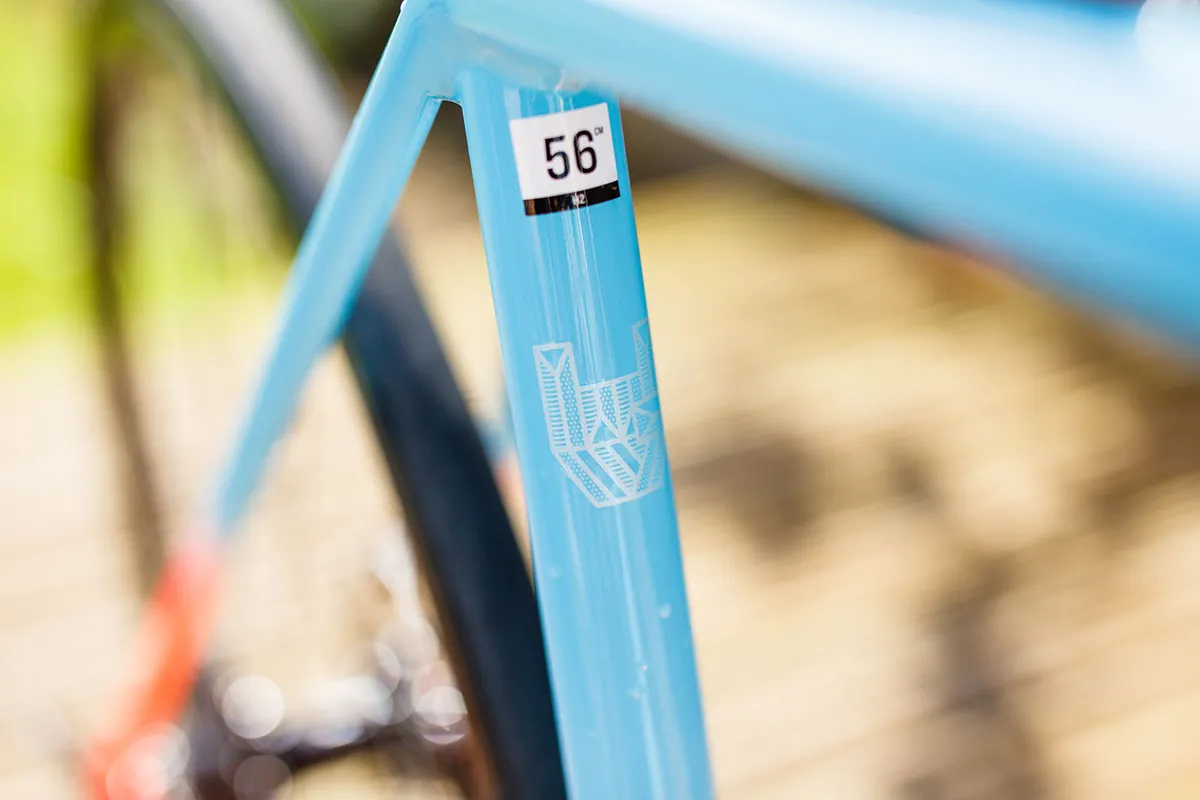
As with the latest Specialized Allez Sprint , the updated aluminium frameset is the headline act on the Émonda ALR.
Like its carbon sibling, it features a mix of round tubing and truncated aerofoil – or ' Kammtail' – shapes.
The frame is constructed from Trek’s 'ultra-light' 300 Series Alpha aluminium, while the fork is made from carbon fibre.
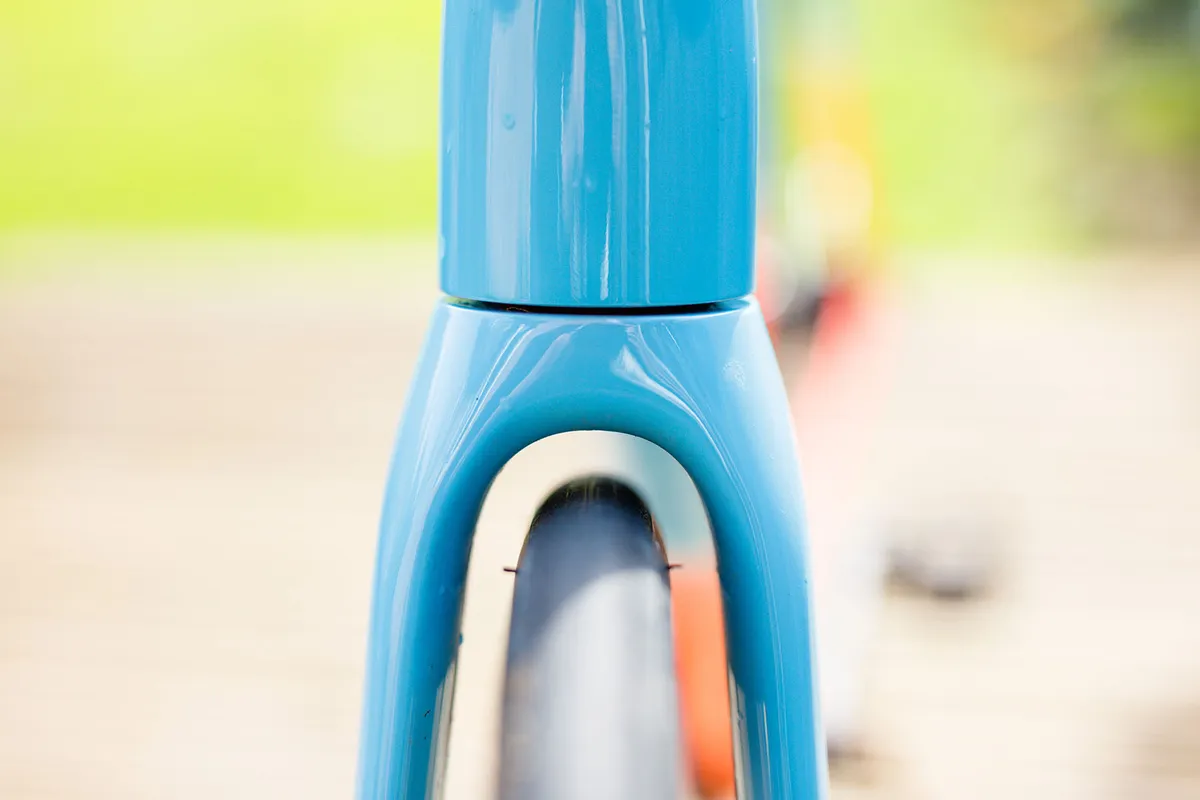
Trek says a painted, size-56cm Émonda ALR frame weighs 1,257g, while the fork is said to weigh 406g.
That’s just 34g heavier than Trek’s Émonda SL carbon frameset (£2,950), which uses Trek’s second-tier carbon layup (Ultralight 500 Series OCLV Carbon) and has a claimed weight of 1,245g and 384g for the fork.
If you wanted to drop any serious weight from the frame, you’d need to step up to the Émonda SLR frameset (£4,900), which features a 760g frame and 381g fork.

The Émonda ALR frame is built using Trek’s ‘Invisible Weld Technology’, which (as the name suggests) helps hide the tube joints for a more seamless look.
Those at the rear dropouts aside, the resulting welds are certainly less prominent than those on the Allez Sprint or Cannondale CAAD13 .
The new Émonda ALR frameset also uses a T47 threaded bottom bracket .
Improved aerodynamics
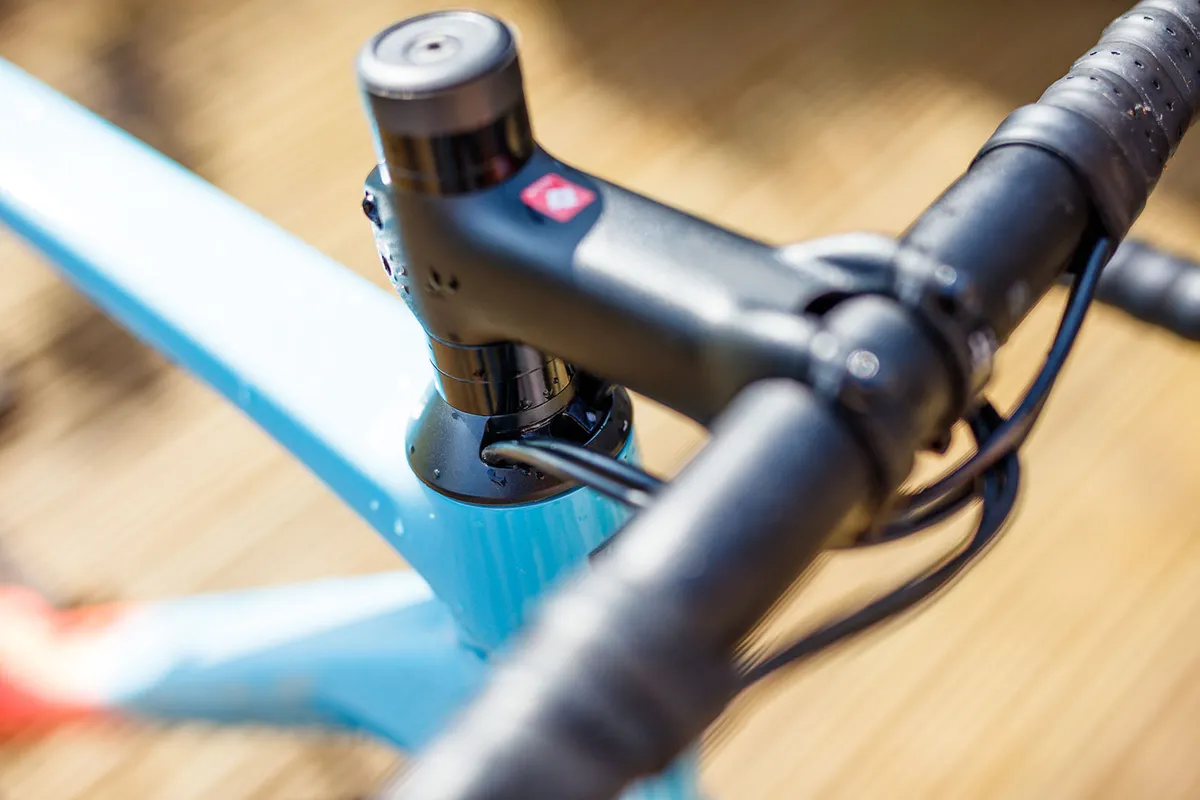
At the front end of the frameset, Trek has adopted an integrated cable-routing solution similar to that on the Allez Sprint and Cervélo Soloist .
This sees the gear cables and brake hoses route externally of the handlebar and stem, and enter the frame through a slotted headset top cap.
This and the aero tubing are claimed to improve the aerodynamic efficiency of the Émonda ALR compared to its predecessor, although Trek doesn’t offer any specific figures to quantify this.
Though I’d prefer Trek to be up-front about the magnitude (or otherwise) of any potential performance boost, I suspect most prospective buyers won’t be overly fussed.
The Émonda ALR isn’t attempting to compete with the best aero road bikes , and the cables and hoses have likely been hidden for aesthetic reasons as much as performance ones.

As I’ve explored before, the performance gains from fully internal cable routing are fairly small and the downsides (such as more complex headset servicing ) can be irritating.
This style of solution does at least allow for a wide range of easy adjustments for bike fit purposes, though, and there’s no denying it lends the bike a premium, modern look.
In fact, it was notable how many admiring comments the Émonda ALR 5 attracted during testing, from cyclists and non-cyclists alike.
While the ‘Azure to Living Coral Fade’ paintjob wouldn’t be my first choice, if you like getting attention for having a 'cool bike', it would seem this is a solid option.
What about mudguards?
One notable omission from the Émonda ALR is mounting points for mudguards or fenders .
While dry-bottom obsessed riders, such as my friend and colleague Jack Luke , have cried foul and made their misgivings on this subject clear, I’m not sure it’s a huge loss.
It’s true that tastefully hidden mounts, such as those on the Trek Domane SLR , don’t add much weight or detract from a bike’s looks when not in use.
However, it’s also fair to say the Émonda ALR (like the Allez Sprint) is intended to be a race bike and – for better or worse – most road racing bikes don’t have mudguard mounts these days.
In any case, if you want an aluminium road bike for year-round riding, Trek also offers the Domane AL , which has a plethora of mounts available for mudguards, extra bottles and more.
Trek Émonda ALR 5 geometry and handling

The Trek Émonda ALR 5 adopts the same H1.5 geometry featured on the latest carbon Émonda and Trek Madone SLR .
This sits in the middle of Trek’s previous pro-style H1 and more relaxed H2 fit geometries. It means most riders should be able to customise the front end to get their preferred fit – whether that’s long and slammed or shorter and more upright.
In terms of its overall aggressiveness, the Émonda ALR sits between the Allez Sprint and CAAD13.
With 391mm of reach and 563mm of stack on my size-56cm test bike, it’s a little higher and shorter than an equivalently sized Allez Sprint.
While the head tube angle is shared with the Allez Sprint at 73.5 degrees, the Émonda ALR has 3mm more fork trail, which slows down the handling slightly.
Overall, the Émonda ALR’s handling still feels light and nimble, though just a touch more mellow than the Allez Sprint’s.
It’s also notable that the Émonda ALR frameset is available in eight sizes, from 47 to 62cm, compared to six sizes (from 49 to 61cm) for the Allez Sprint.
Trek Émonda ALR 5 build

As with most bikes at this price, the Émonda ALR 5’s build is somewhat of a mixed bag.
Trek has wisely specced Shimano 105 R7000 , the Japanese brand’s highly rated 11-speed workhorse groupset.
You get climbing-friendly 50/34-tooth chainrings up front, paired with a short-cage rear derailleur and an 11-30 tooth cassette.

Finishing kit is by Bontrager (Trek’s in-house wheel and component brand), in the form of a basic aluminium seatpost, stem and set of round handlebars.
While it lacks a posh carbon seatpost, the use of a round, 27.2mm post means aftermarket upgrade options are plentiful.
It’s the same story up front – no surprises or odd standards, just a 1-1/8in steerer and a 31.8mm handlebar clamp.
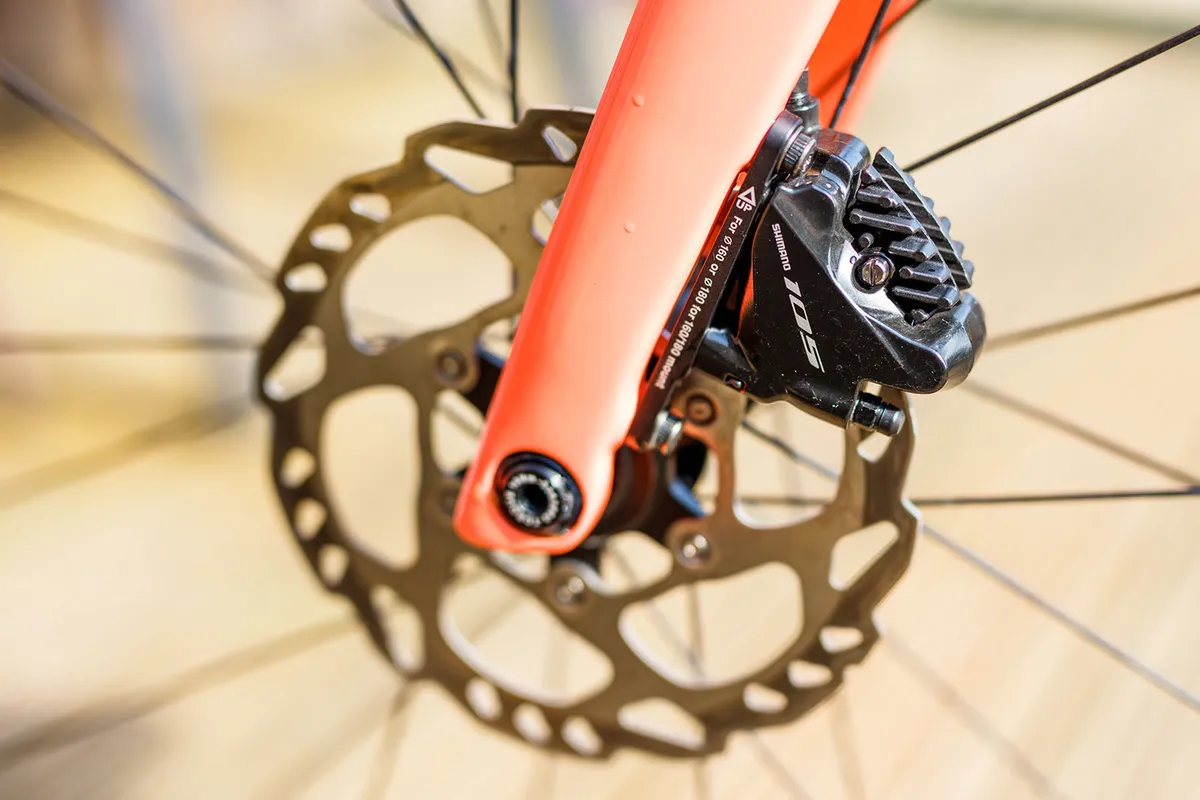
In an era when the use of proprietary parts on road bikes seems to be ever increasing, such simplicity and wide-ranging compatibility feels like a breath of fresh air.
In terms of wheels and tyres, Trek has specced a set of basic Bontrager alloy wheels paired with 700x25c Bontrager R1 Hard-Case Lite clincher tyres.
While the alloy Bontrager hubs and round spokes are fairly run of the mill, the Bontrager Paradigm SL rims are at least tubeless-ready and have a healthily wide, 21mm internal rim width . This helps plump the tyres up to around 28.5mm at 70psi/4.8 bar.
Trek Émonda ALR 5 ride impressions

Out on the road, the Émonda ALR 5 is an easy bike to get along with.
It has a marginally more relaxed personality than the Allez Sprint, but for many this will be a plus (the Allez Sprint is very racy).
Like that bike, though, the Émonda ALR belies its 9.04kg weight, feeling quick to respond to inputs and generally easy to manoeuvre.
Shimano’s 105 R7000 groupset remains as impressive as ever. Shifts are slick and fast at both ends, with excellent braking.
Unsurprisingly, the low-end Bontrager tyres disappoint compared to the best road bike tyres currently available, and make the bike feel sluggish when trying to ride fast. Upgrading these alone would likely do wonders for the whole package.
The Bontrager finishing kit is nothing flashy, but it all does the job and can be replaced easily if you have particular tastes or bike fit requirements.
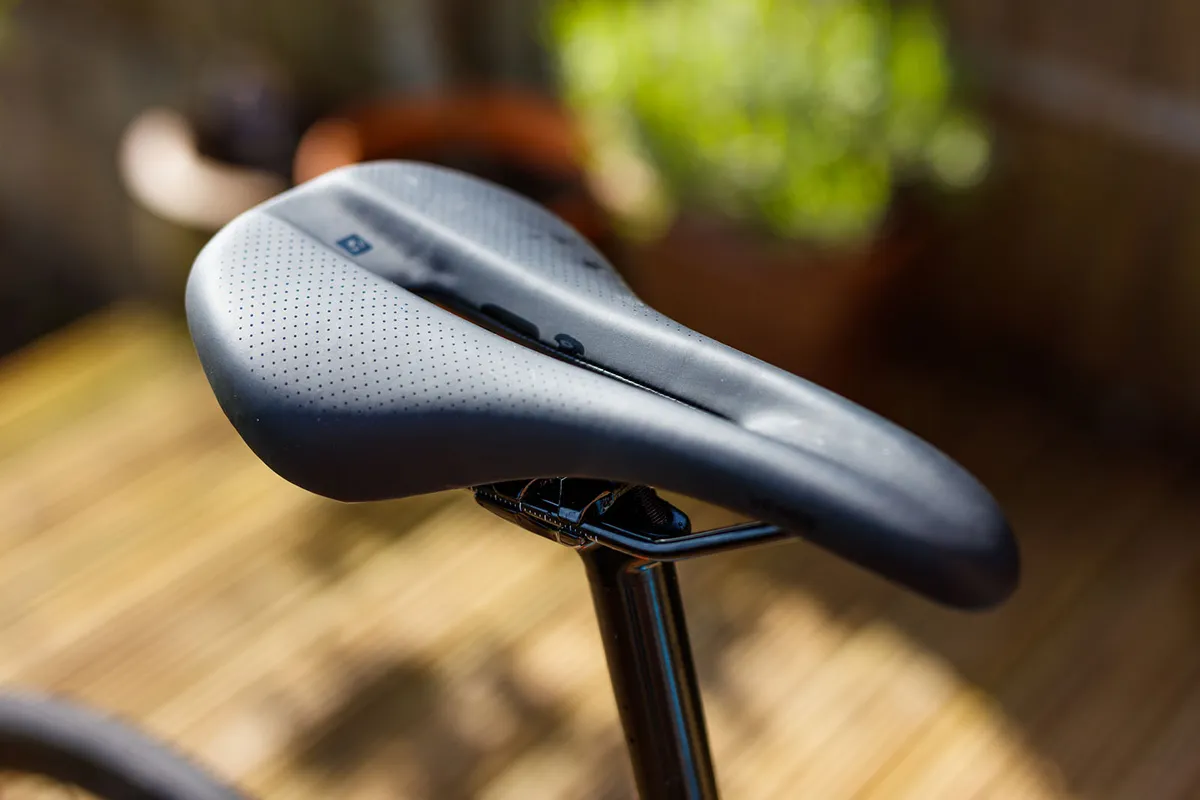
The only part I didn’t get on with was the Bontrager Verse Comp saddle. It has a lot more padding than I’m used to and I quickly swapped it out for something firmer and shorter (a Giant Fleet SL).
It’s a shame Trek didn’t spec the excellent Bontrager Aeolus saddle, versions of which come with higher-end Émonda and Madone builds, but that’s a minor gripe.
The ride quality is also impressive, especially at the rear end.
While dropped seatstays and carbon seatposts are often lauded for their comfort-enhancing properties, the Émonda ALR manages to achieve a smooth ride without either.
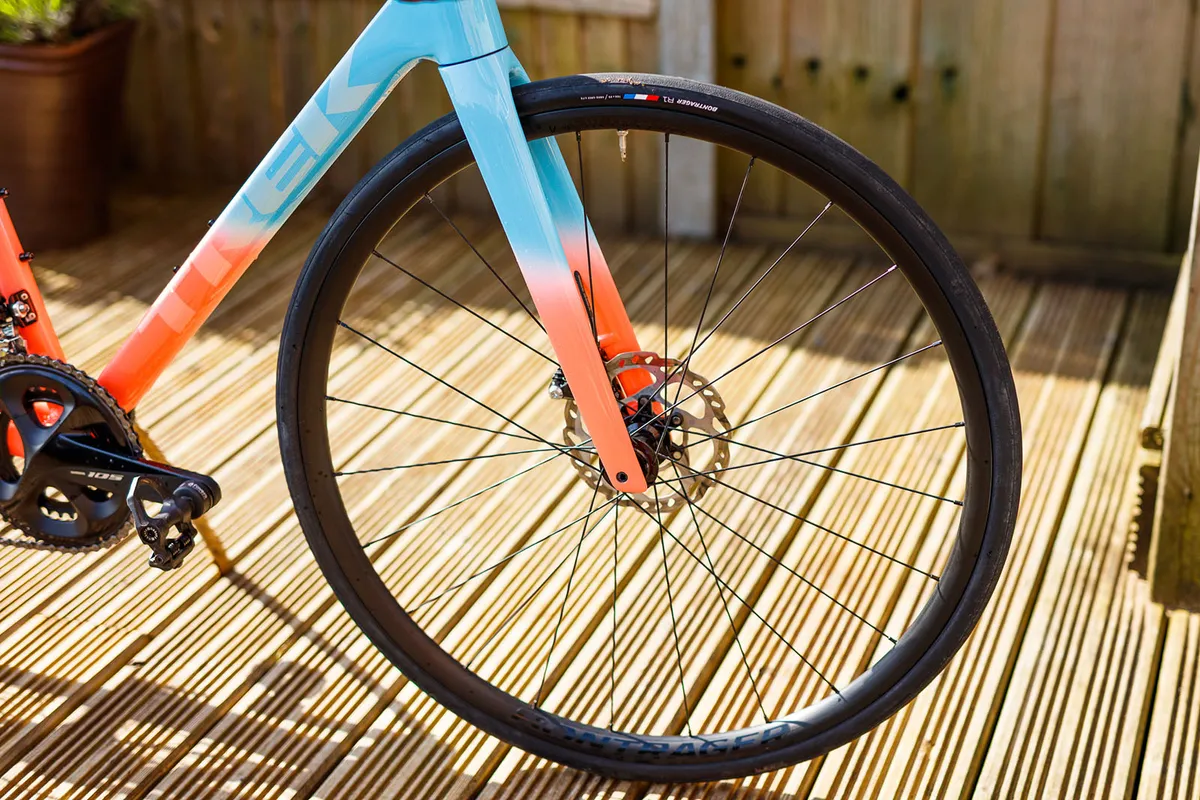
The front end, with its stiff carbon fork and basic alloy bars, is firmer. Careful adjustment of the tyre pressures went a long way to mitigating this, though.
The Émonda ALRs tyre clearance is officially capped at 28mm, as on the previous version , but in practice there’s ample room for more.
Trek Émonda ALR 5 bottom line

The Trek Émonda ALR 5 joins an increasing number of high-quality aluminium road bikes.
Despite its alloy construction, it’s only marginally heavier than the mid-tier carbon Émonda and offers an appealing mix of classic looks and modern tech.
Likewise, if you want a road racing bike with Trek on the down tube, then the Émonda ALR is one of the cheapest entry points and it doesn’t disappoint in terms of performance.
Hitting this price inevitably means compromises in the build, but (tyres aside) everything does a respectable job, and – best of all – can be easily customised to suit your personal tastes.
Share this article

Senior technical writer

- Terms & Conditions
- Subscribe to our magazines
- Manage preferences

- Auto Expo 2020
- First rides
- Comparisons
- Gear review
- Product review
- Product picks
- Bike features
- Riding tutorials
- Classic bikes
- Buy on Amazon India
- Digital mag
- Evo India Magazine
- Motor Sport India
- Women on wheels

Trek Emonda ALR 4: Test Ride review
We all love carbonfibre but that does come at a cost. Frame builders can manipulate steel in many ways. But, this adds to the overall weight. And when it comes to cycling, you have to be fit enough to be able to produce kinetic energy. And that makes aluminium the obvious choice. Trek has done wonders with aluminium on the recently introduced Emonda ALR 4 and ALR 5 .
Trek has priced the new Emonda ALR 4 quite reasonably when compared to its carbonfibre counterparts. And it is stiff enough despite not weighing much. Add Trek’s attention to details and what you get is a gorgeous cycle. And we are going to tell you if it’s worth spending your money on.
Frame game on the Trek Emonda ALR 4
It is not easy to beat the Emonda ALR 4 at least on paper and the weighing scale. The Emonda ALR 4 is just 40g heavier than its fancier and costlier cousin, the SL, made from carbonfibre. Trek also say that the Emonda ALR 4 chassis is almost as stiff as the SL’s. This is thanks to the 300-series Alpha Aluminium hydroformed tubes that use nearly the same shapes as the high-end Emondas. The frame features an internal cable routing through the front triangle, provisioning for the Bontrager DuoTrap S speed and cadence sensor in the non-drive chainstay, press-fit BB86.5 bottom bracket, 27.2mm seat post, and tapered headtube.
Like Fast Bikes? Follow our Twitter , Facebook and Instagram pages for thrilling content
Does it ride well?
The Emonda ALR 4 handles similar to the carbon Emonda models. That is because all these bikes are derived from the Madone range. It’s stable at high speeds, reasonably agile at low speeds, and loves to go around corners. It seems that Trek hasn’t changed its old but bold road geometry in ages. And it’s gold. The geometry of the ALR 4 is the same as most of the Émonda carbon line. Trek uses its H2 fit, which is meant for the everyday rider. This geometry falls between the race geometry you’d find on a bike like the Specialized Tarmac, and the shorter, more upright geometry of an endurance bike. The riding position worked out well for me (5ft 8in), although someone looking for a more aggressive ride might have to get the head tube replaced with a shorter one.
“The frame needs to be lauded, as it offers the ability to lean as hard as possible. The feedback is tremendous.”
If this is your first road bike then its stiffness and lightness will surprise you . If you’re not a first-timer then then the ride and build quality that comes at this price point will amaze you. The USP is the ride, especially with the Bontrager R1 Hard-Case Lite tyres on the Bontrager Affinity Tubeless ready rims that offer enough grip on the road. Apart from being stiff and alive, the out-of-saddle riding is perfectly aggressive, yet so smooth, that too without incorporating hardcore technology. The frame needs to be lauded, as it offers the ability to lean as hard as possible. The feedback is tremendous. And while going up the hill, the Shimano Tiagra 10-speed gear, the Bontrager Montrose Comp saddle on the Bontrager alloy, 2-bolt head seatpost, the Bontrager Comp VR-C, 31.8mm handlebar and a pair of Bontrager taped grips come in handy for a comfortable ride. Although, the directly mounted Tektro T731 rim brakes could have had a better bite.
To buy or not to buy?
It’s made for blacktop lovers who love riding at high speeds, regardless of the distance. Of course, Trek has designed the Emonda ALR 4 keeping the track in mind, and that makes it delightfully light and agile. However, that does not mean that you cannot take it out on Sundays when your buddies take a trip to the closest hilltop. It’s equally comfortable cutting through traffic which is where riders are going to take it, most of the times. Add to it is the brilliant ride and handling setup. Even the price-to-performance ratio is high. Combine that with drop dead sexy looks and the Emonda ALR 4 will also add value to your drawing room!

Gear-obsessed editors choose every product we review. We may earn commission if you buy from a link. How we test gear.
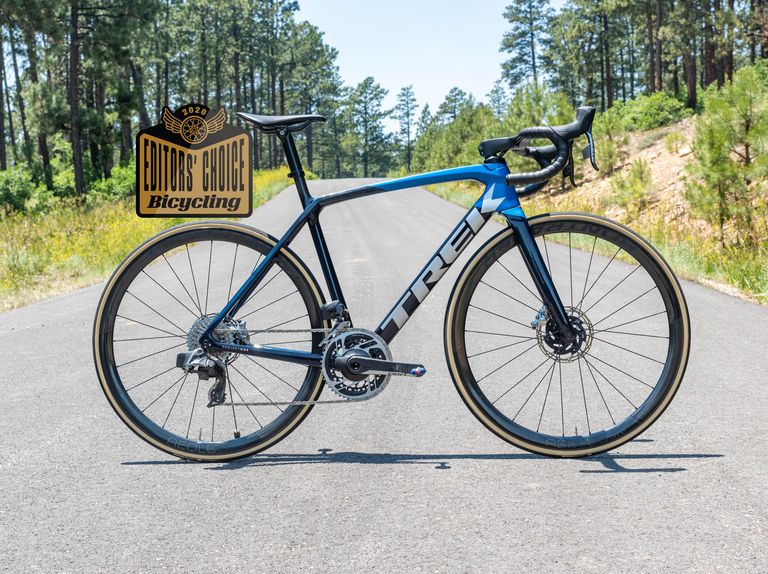
The New Trek Émonda Is Faster Than Ever
Already one of the fiercest climbing bikes available, the new Émonda is even faster thanks to a dose of aero.
The Takeaway: The Émonda SLR is a benchmark pro race bike—and it’s surprisingly rider friendly.
- It has 183 grams less drag than the previous generation, but the frame is only 33 grams heavier
- There are 10 models starting at $2,699
- SL models ($2,699 to $5,999) have the aerodynamic shaping and features but in a frame that’s about 400 grams heavier than the SLR
- SLR models ($6,699 and up) use a new carbon fiber composite that’s 30 percent stronger than Trek’s previous top-of-the-line carbon.
For Émonda SLR bicycles, Trek will provide an individual handlebar and stem until an updated handlebar/stem combo is available.
Additionally, all customers who bring in their handlebars for replacement will also receive a $100 in-store credit that can be used toward any Trek or Bontrager merchandise through December 31, 2022.
Remember professional road racing ? It’s that thing where super skinny people go unbelievably fast up and down hills and fly over flat roads for hours at a time. It’s been a while since the pros have beat up on each other for our entertainment, but there might, hopefully, be some races on the horizon. When the races do resume, Trek’s pro riders will be aboard its new third-generation Émonda climbing bike. The new Émonda isn’t lighter, but it is faster thanks to a dose of aerodynamic tuning.
.css-1hhr1pq{text-align:center;font-size:1.1875rem;line-height:1.6;font-family:Charter,Charter-roboto,Charter-local,Georgia,Times,Serif;}.css-1hhr1pq em{font-style:italic;font-family:Charter,Charter-styleitalic-roboto,Charter-styleitalic-local,Georgia,Times,Serif;}.css-1hhr1pq strong{font-family:Charter,Charter-weightbold-roboto,Charter-weightbold-local,Georgia,Times,Serif;font-weight:bold;} —Five Cool Details—
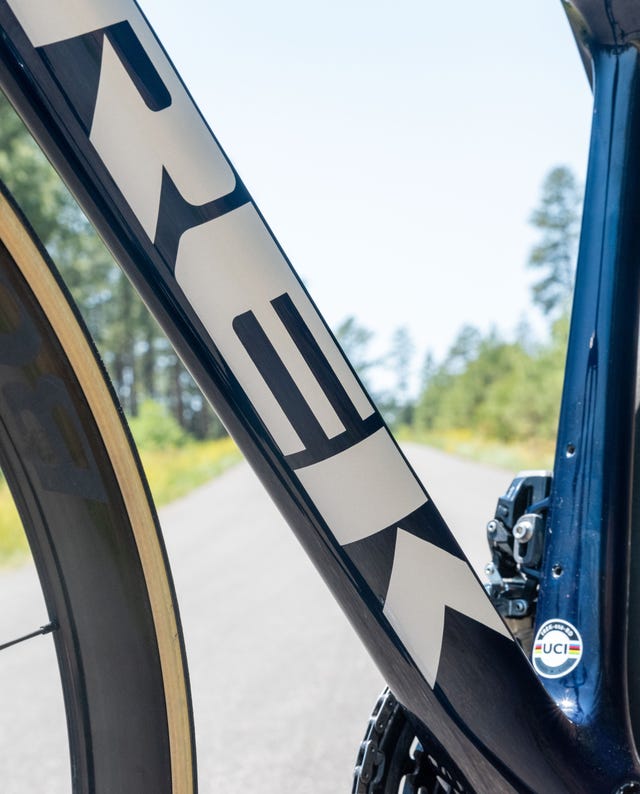
Now With Aero
The new Émonda gets a major drag reduction with a tiny weight gain.
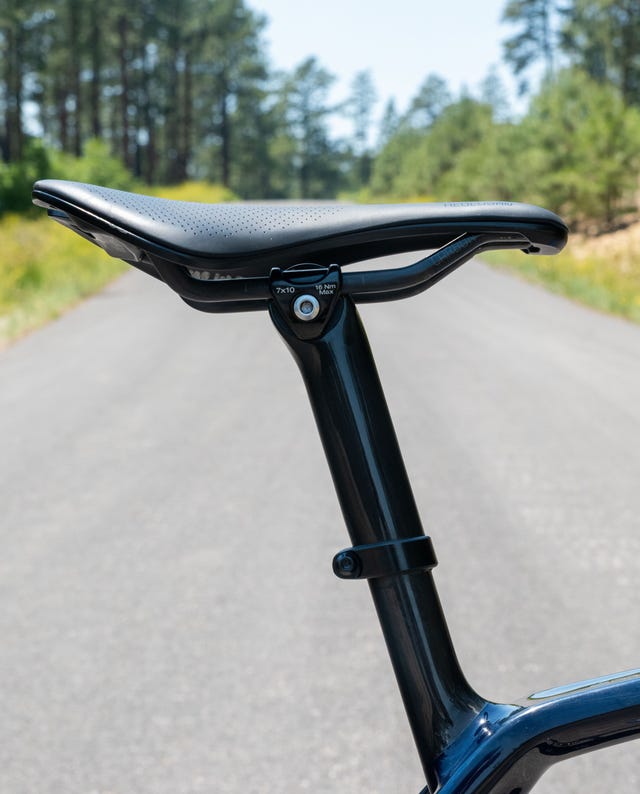
Simple Seat Mast
The seat mast has lots of adjustment range, and an easy-to-use saddle clamp.
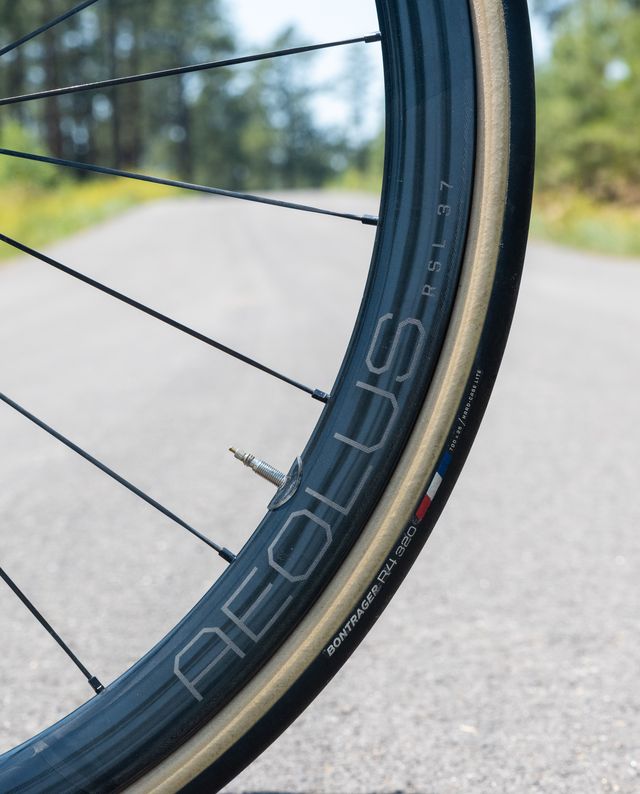
Light and Slippery
The new Bontrager Aeolus RSL 37 wheels are light, sleek, and stable.
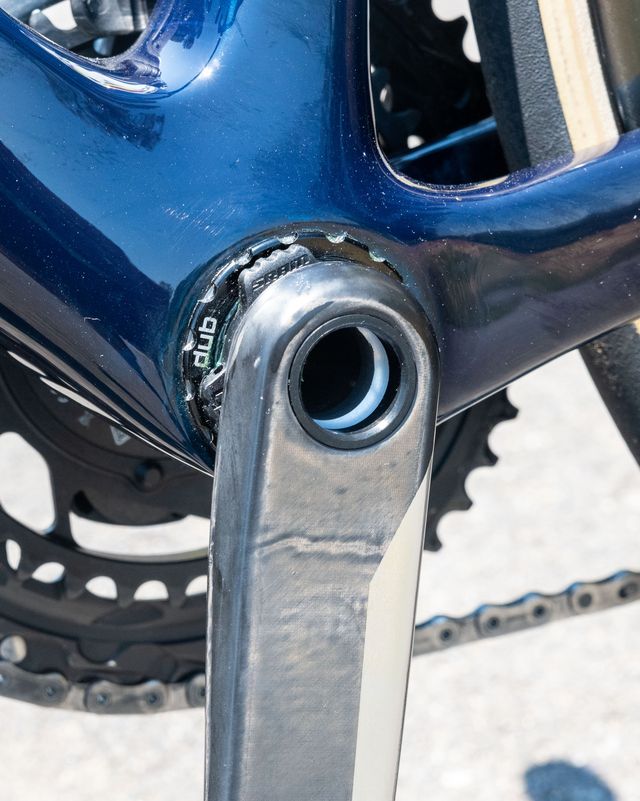
Wide and Threaded
The T47 bottom bracket has a wide stance, and user-friendly threads.
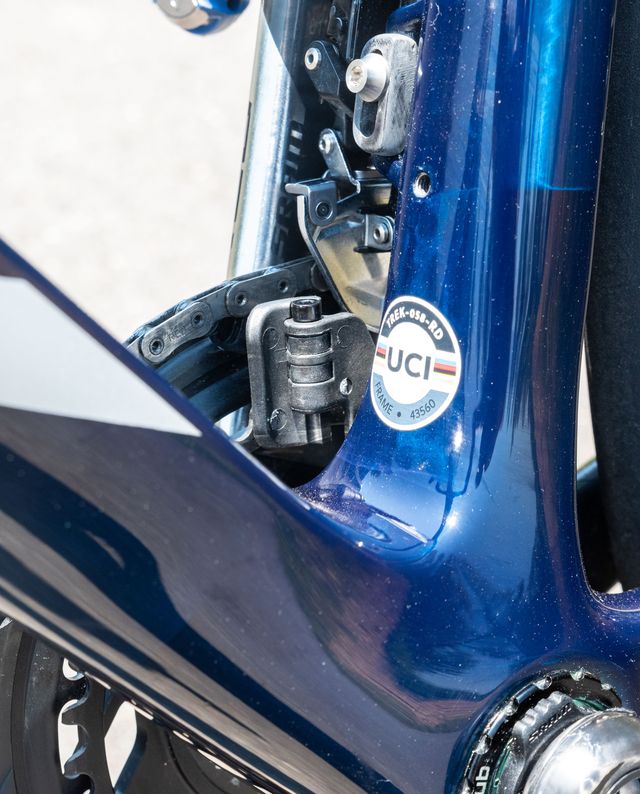
A built-in chain watcher prevents unwanted derailments.
Making the new Émonda frame more aerodynamic wasn’t exactly a tough hurdle as the previous Émonda had virtually zero aerodynamic optimization. But adding meaningful aerodynamic benefit while achieving the frame stiffness expected of a pro-caliber race bike, maintaining the well-regarded handling properties of the previous Émonda, and adding rider-friendly features like a threaded bottom bracket—all with adding only 33 grams (SLR frame, claimed)—is quite a feat.
Below you’ll find my review of the Émonda SLR—I’ve been on it since early March—followed by a dive into the technology and features of the new bike, and a brief model breakdown.
Ride Impressions: Émonda SLR 9 eTap

The Émonda SLR is a tool made to fulfill the needs of some of the world’s best road racers. This bike will never be as comfortable or versatile as a gravel bike. Going fast on pavement and climbing performance are its only goals. These are obvious facts, but that’s the lens through which it must be viewed. And through this lens, it is one of the very best.
The new Émonda was born out of a request from Trek’s pro racers and pitched as the company’s “fastest climbing bike ever.” So little surprise they set me up with the lightest model (the SLR 9 with SRAM Red eTap ), which also has a build kit almost identical to the team’s bikes. It’s also, excepting customized Project One builds, the most expensive model at a buck under 12 grand.
That massive pile of clams gets you an aerodynamic frame with disc brakes, power meter, and wireless electronic shifting that weighs less than 15 pounds (54cm). And that’s with a hefty T47 threaded bottom bracket unit, lustrous paint , clincher wheelset, a chain-watcher, standard butyl tubes, 37mm deep rims, 160mm disc rotors front and rear, and SRAM’s largest Red cassette (10-33). That’s “Holy shit!” impressive.
By cutting drag a ton without adding much weight, it’s hard to argue with Trek’s claim that the new Émonda is faster than the outgoing generation. But if you have any doubts, they’ll be erased when you ride it. This is an explosive bike: it feels as light as a feather and as solid as a steel girder at the same time.
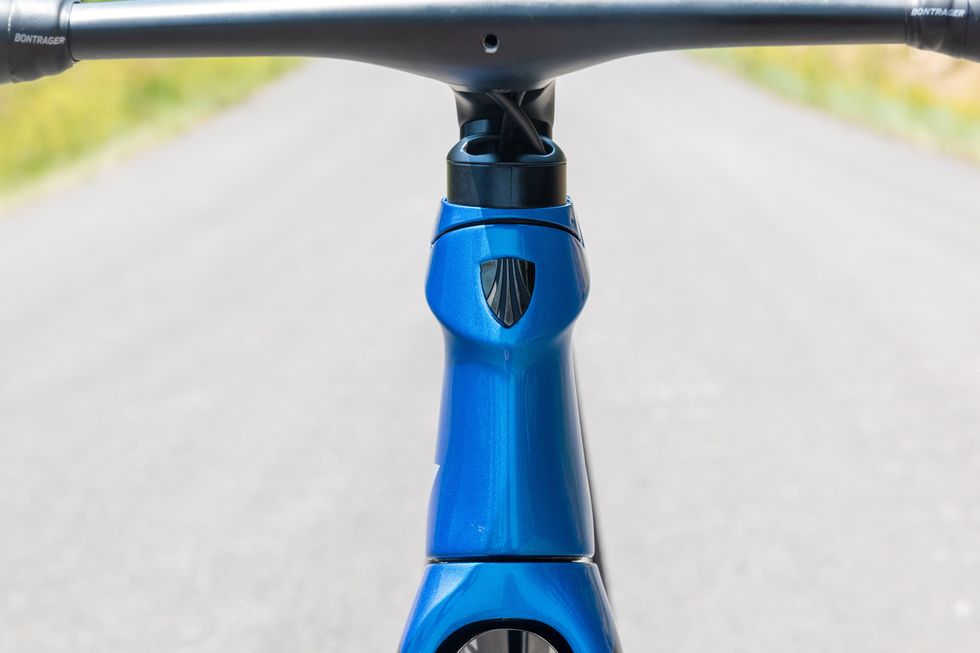
Trek’s Émonda has always been a raw and rowdy bike that feels a little wild and a bit dangerous in precisely the ways you want a race bike to feel: That’s not lost with the added aerodynamics. If anything, the new Émonda is even crisper and punchier than before, which is saying something.

A small downside to all this fury is the Émonda’s smoothness. Light and stiff race bikes aren’t a smooth-riding lot to begin with, but even measured against a stiffer riding genre, the new Émonda is on the firmer end of the scale. Still, it escapes harsh or punishing labels—I did a six-hour ride on the Émonda on the stock 25 tires and didn’t feel worn down by its ride. Swapping to 28s helped a lot (no surprise) and were on the Émonda for the bulk of my testing. I’d suggest reserving the lighter and more aerodynamic stock 25s for racing or PR attempts—assuming good roads—and use 28s as daily drivers.
The Émonda’s handling is excellent. Well, let me caveat that: Road racing geometry is pretty uniform, so whether I’m on a current race bike from Trek, Specialized, Cannondale, Cervélo, Canyon, Colnago, Wilier, Pinarello, BMC, Giant (etc., etc.), I find the broad strokes of their handling feel and performance quite similar. There wasn’t anything about the Émonda’s handling or cornering performance that set any new benchmarks for me, but there wasn’t anything to dislike either.
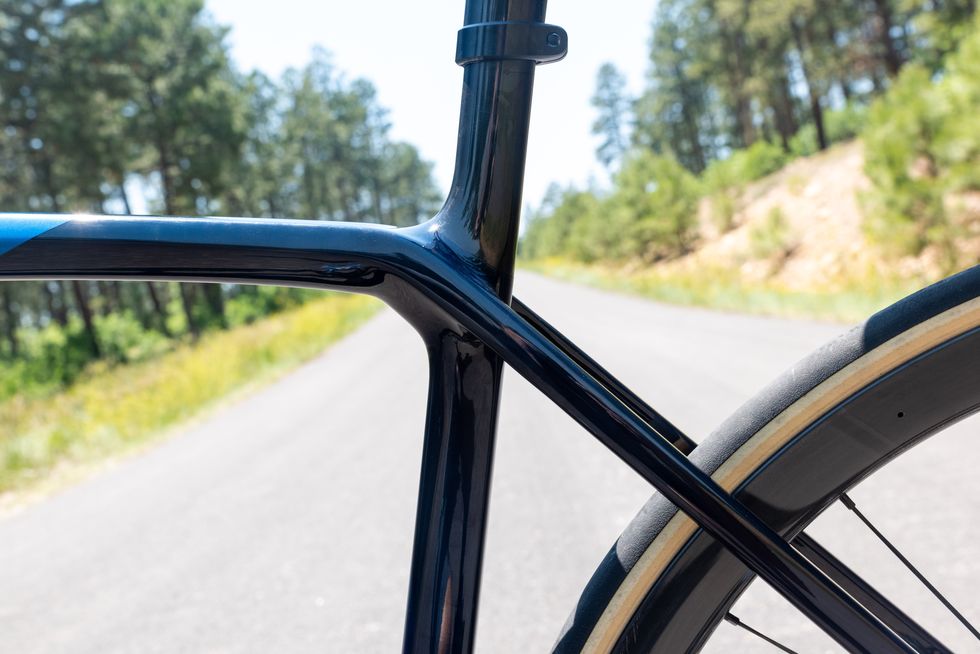
It was quick and accurate, diving into corners with a light touch. It offered great feedback, so I always knew where I was relative to its and my limits, and I could count on it to be consistent and predictable. It was maybe a touch less settled in bumpy corners than the Specialized Tarmac, but the Émonda never broke traction or skipped. Overall, for such a light bike, the Émonda is remarkably solid and drama free. I’d have no qualms barreling down a technical alpine descent on the Émonda.
I received this test bike in early March, giving me plenty of time to ride it back to back with its primary competition—a Specialized S-Works Tarmac , what I consider the benchmark for aero-ized lightweight bikes. The Tarmac is smoother over the bumps and has a silkier feel overall, but the new Émonda feels more efficient, like it can go faster more easily.
I’ve also ridden a good slice of the Émonda’s competition, including the Canyon Ultimate CF SLX , Colnago V3Rs, Cannondale SuperSix Evo , Cervélo R5, Wilier Zero SLR , Pinarello Dogma F12 . These are all superb bikes, but I feel the Émonda is the class leader. It feels sharper and more explosive than all of them. It feels faster, and that’s what matters most in a race bike. But I also like that the Émonda is pretty straightforward and rider-friendly.
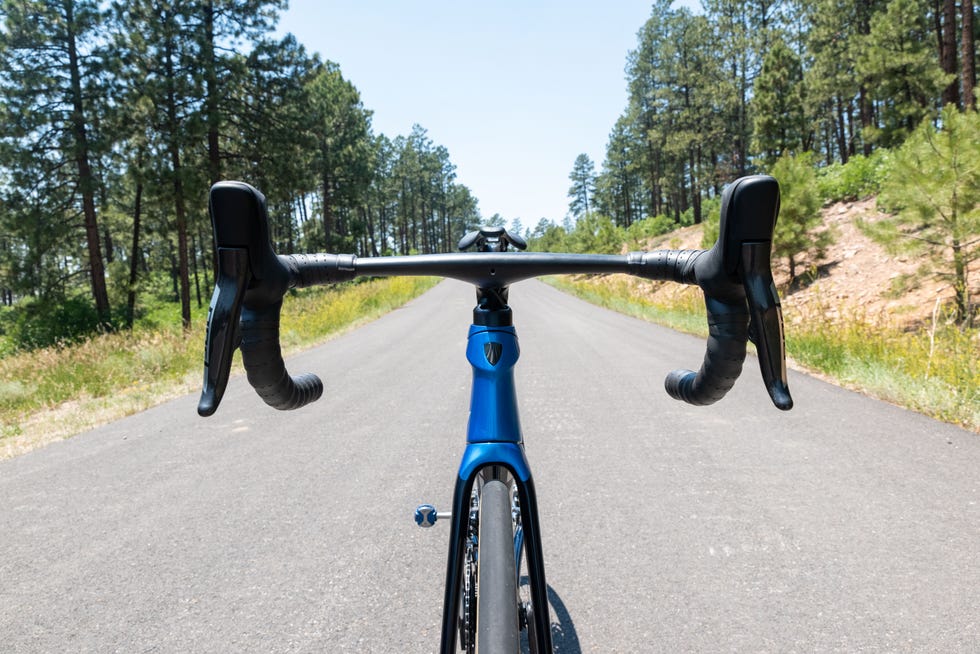
For example, I swapped the stock one-piece bar/stem for a standard stem and round bar. One, I could run a standard bar and stem on this bike, which you can’t say about every modern race bike. And two, I didn’t have to pull any cables, wires, or hoses to make the swap: Again, something you can’t say about all race bikes. For the record, the shape of the one-piece Aeolus bar/stem is great, and the tops are the most comfortable to grab of all the aero-topped bars I've used. The only reason I swapped is my preferred length and width combination (110x40) wasn't available yet.
The BB is threaded, which makes it easier to service and replace than a press-fit (however, I was getting some noise out of the BB area, which I never resolved). The wheels employ standard offset, and it uses regular thru-axles. It’s compatible with pod-style power meters and mechanical shifting. Its signature seat mast is pretty much the only non-standard thing about this frame, and even then, it’s pretty user-friendly. There’s no cutting necessary, height adjustment is ample, the saddle clamp is easy to use, and it’s travel-case friendly.
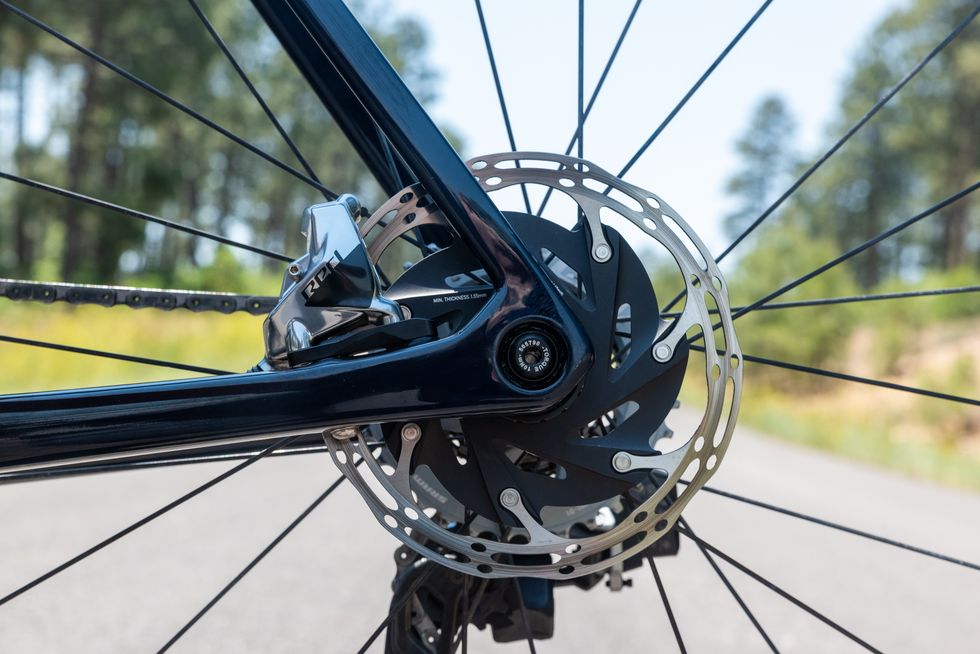
I expect so much from a modern high-end pro-level road racing bike that it’s hard to exceed those expectations. It’s rare when a bike does: The Émonda SLR is one of those rare bikes.
Team Request
The new Émonda is partially a result of a request from the Trek-Segafredo race team. “They are one of our primary customers,” said Jordan Roessingh, Trek’s director of road product. “And they started to realize that it’s not just weight, it’s not just stiffness and responsiveness, there’s this other thing—aerodynamics and speed—that’s also really important to be competitive and be faster on the bike. They had been one of the loudest voices saying, ‘We need the lightest-weight, stiffest bike possible.’ And now they started coming back saying ‘We need those things, but we also need the bike to be faster in order for us to be really competitive.’ ”
It is (comparatively) easy to make a light frame, it is easy to make a stiff frame, it is easy to make an aerodynamic frame. Making a frame that’s two of those three things is more challenging: Making a bike more aerodynamic usually makes it heavier, making a bike lighter typically makes it less stiff, etc. Making a frame that is light AND stiff AND aerodynamic enough to satisfy the demands of a top-level professional race team is extremely difficult.
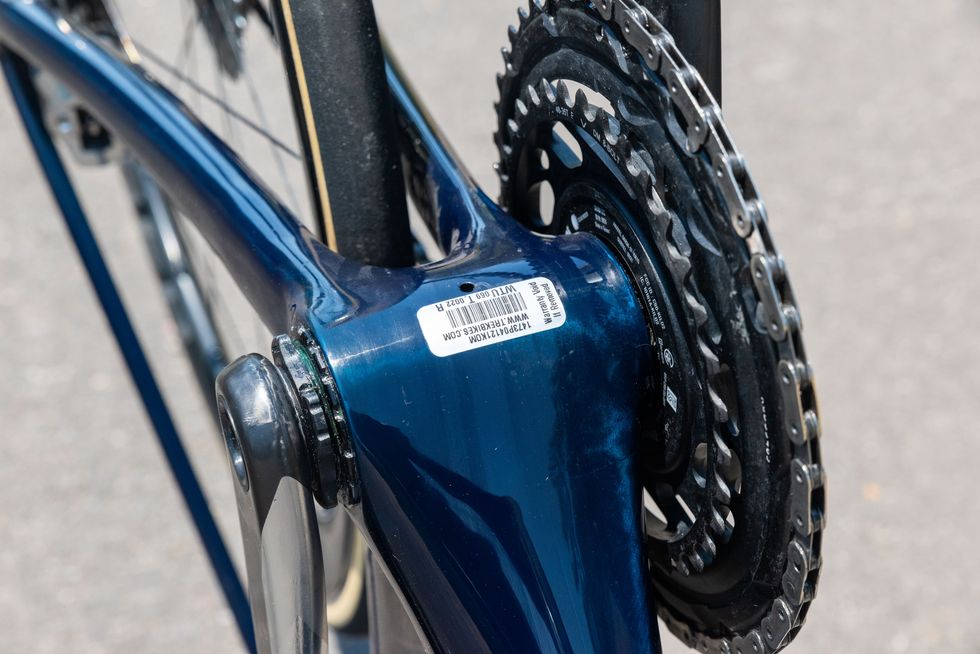
But not impossible. Many brands already make a light, stiff, and aero bike. The Specialized Tarmac is one, as are the Canyon Ultimate, the Cannondale SuperSix Evo, the Cervélo R5, the Wilier Zero SLR, the Pinarello F12, the Scott Addict, and the new Giant TCR . All of them seek to balance the three qualities—light, stiff, and aero—in the pursuit of the ideal race bike, and they all manage the balance differently. The common thread between these bikes: They’re all used by teams that compete against Trek-Segafredo.
Still Light, Now With Aero
The previous generation Émonda SLR Disc , launched in 2017, was an extremely light frame at 665 grams (claimed). But when a frame is already that light, it is much harder to make it even lighter. At least lighter enough to make a meaningful difference.
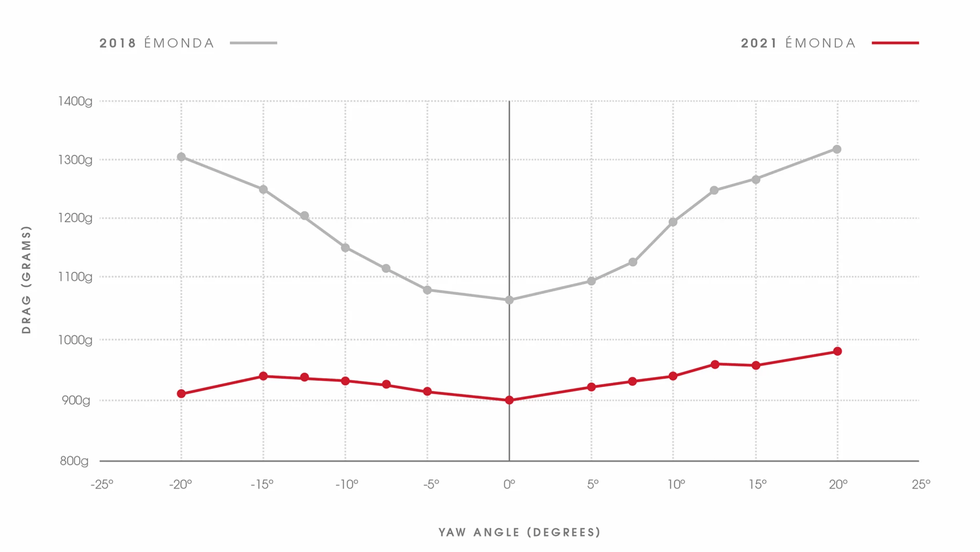
So, Trek took a different approach to making its climbing bike faster—instead of lighter, it made it more aerodynamic. The new Émonda frame is a touch heavier—yet still extremely light at 698 grams—but the bike has 183 grams less drag than the previous generation.
The important thing to note here is that, though the frame is more aerodynamic, the 183 gram drag reduction is not from the frame only. New wheels and a new aero bar (more info on both below) play a role. The specific setups Trek used to get that 183 gram number are: 2018 Émonda with 28mm-deep Bontrager XXX 2 wheels, and Bontrager XXX Bar/Stem Combo compared to the 2021 Émonda with 37mm deep Bontrager Aeolus RSL 37 Wheels and Bontrager Aeolus RSL Bar/Stem Combo.

Another drag saving upgrade: the housing, hoses and wires for the controls are almost fully inside the frame. They dive into the frame at the head tube passing through the upper headset bearing. The front brake hose runs into the fork steerer and down the left leg before popping out just above the brake caliper. The fork steerer’s flattened sides provide room for the rear brake hose and derailleur control lines to travel down and into the frame. Though it has flattened sides, the fork steerer is still compatible with standard 1 1/8” stems.
The overall drag reduction results in a bike that is 18 seconds per hour faster when climbing an 8.1 percent grade (the average grade of Alpe d’Huez ), and 60 seconds per hour faster on flat roads than the previous Émonda. Trek also claims the new Émonda is 13 seconds per hour faster than a Specialized Tarmac when climbing an 8.1 percent grade (all assuming the rider maintains a constant 350 watts).
Eight Point One Percent
With three qualities—aero, stiffness, weight—that work in opposition to each other, how do you decide how much to optimize one quality when you know it will negatively affect the other two? How aero is aero enough? At what point is improved aerodynamics offset by the weight added to get there?
The team behind the Émonda used a legendary climb to help them decide: Alpe d’Huez. “It represents an extreme example of what most people see on a regular basis when they’re doing a big climbing ride,” said Roessingh, “It’s around an 8 percent grade, and it’s about an hour-long climb for the pros—amateurs might go a little slower. It gives us a good understanding of what the benefit of a drag savings is relative to a weight savings.”
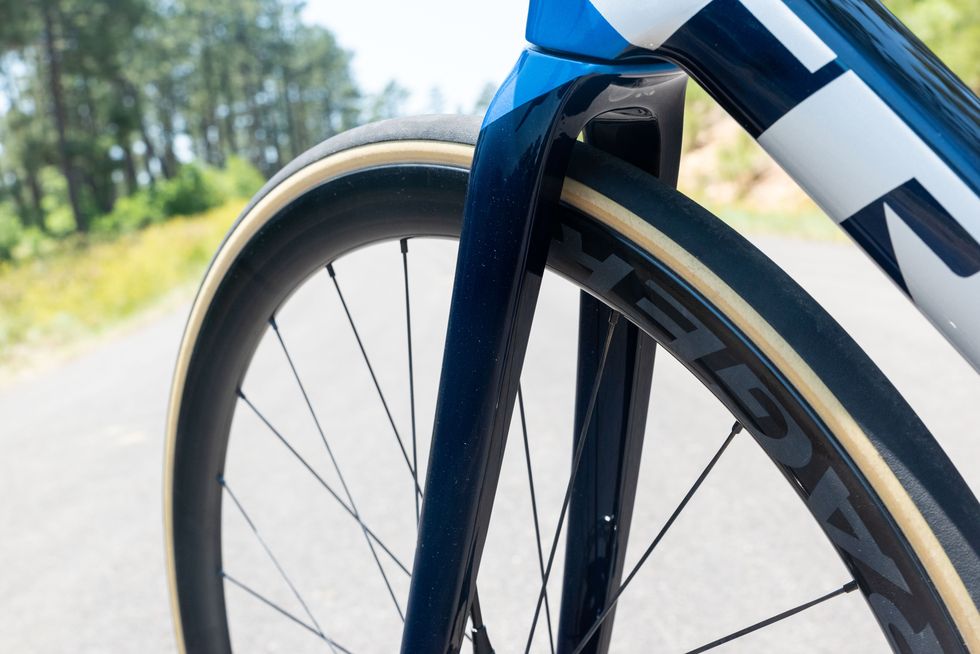
By optimizing the weight and aerodynamic balance around this climb, Roessingh claims the Émonda is faster on Alpe d’Huez and also faster on everything shallower than the famous climb, “which is the vast majority of the environments that most riders are going to ride in, including the team,” said Roessingh. “So if we can say it’s faster up Alpe d’Huez, it’s going to be significantly faster everywhere because the flatter it is, the more aerodynamics benefit you.”
Computer-Aided Optimization
Achieving the weight to the aerodynamic balance of the new Émonda required careful design of each tube shape. Aiding the Émonda’s team was supercomputing horsepower. The abridged and simplified version of the process goes like this: into the computer was fed a rough draft of the shape based on Trek’s aerodynamic experience and other information like UCI regulations. The program then varies the tube’s parameters within a predefined range and spit back several iterations of the shape, each with a different weight to aerodynamic balance. The Émonda’s team evaluated the alternatives and picked the one most suited to its location in the frame and best able to help the frame achieve its overarching goal.
Roessingh says that Trek cannot afford to buy the computing hardware necessary to run the CFD and FEA optimizations (in a timely manner) that helped shape the new Émonda’s tubes. The processing happens in the cloud where Trek rents time on Google, Microsoft, or Amazon’s supercomputers. It’s more affordable than buying a supercomputer. Even so, it is not cheap, “Cloud computing is becoming a relatively significant budget line item for us because we’re doing so many of these optimizations in CFD and FEA and all that processing happens in the cloud.”
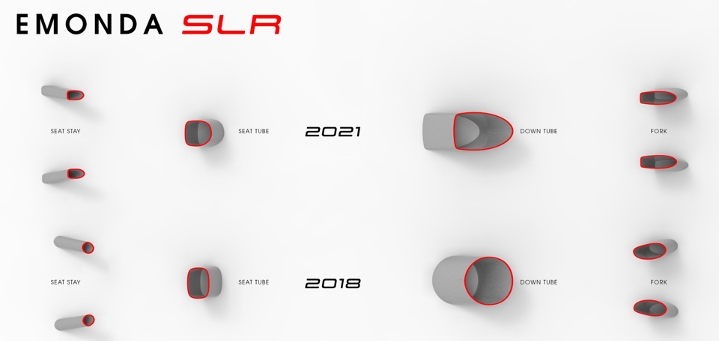
The new Émonda’s fork legs, head tube, down tube, seat tube, and seat stays all use a variation of a truncated airfoil. The top tube and chainstays, which have virtually no effect on drag, are optimized almost entirely for stiffness to weight.
In Trek’s line, the new Émonda’s aerodynamic performance is equal to the third generation Domane ; the Madone is still significantly more aero. But while the more aerodynamic Madone is faster in flatter terrain, once the climb hits about 5.5 percent, the lighter Émonda becomes the faster bike. And for many of the Trek-Segafredo team riders—and many amateurs—that means the Émonda is fastest when it matters most: the hardest part of a race or ride, which is almost always on a steep climb.
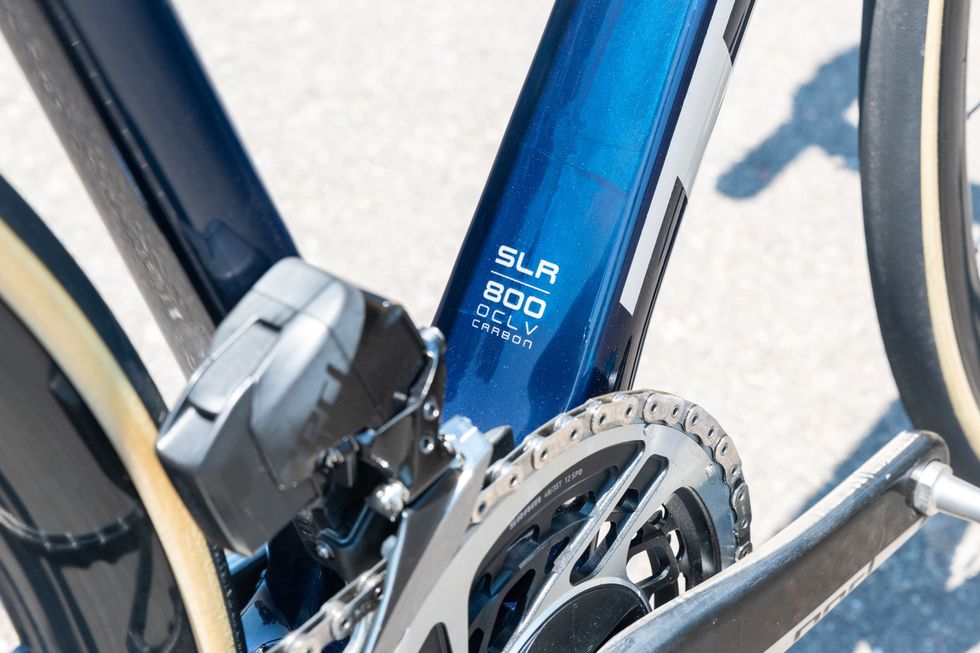
OCLV 800 Carbon
Getting the new Émonda SLR to be as light as it is while adding aerodynamic shaping would not be possible without employing a new carbon-fiber composite, said Roessingh. The new OCLV 800 composite is 30 percent stronger than Trek’s previous top-of-the-line composite (OCLV 700). Because it is stronger, they can use less: By using OCLV 800, Trek’s team was able to make the Émonda SLR frame 60 grams lighter than if they used OCLV 700.
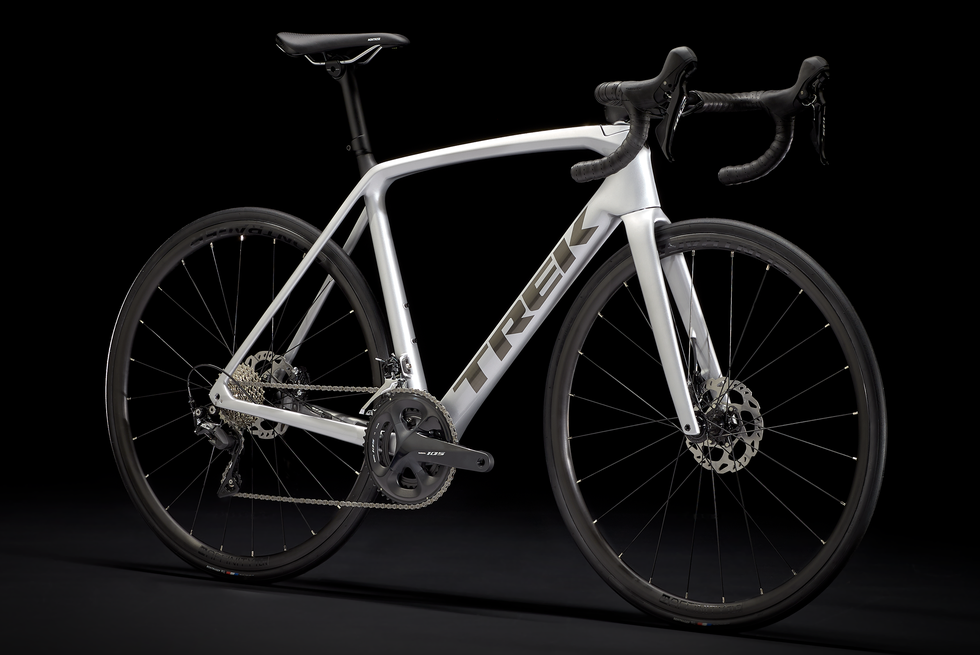
The Émonda SLR is very cool, but it’s also very expensive (bike prices start at $6,699). For the 99 percenters, there’s the Émonda SL (models start at $2,699).
The SL uses OCLV 500 composite, and the frame is quite a bit heavier than the SLR’s. The SL’s frame comes in at 1,142 grams, with a 380-gram fork (SLR fork weight: 365 grams).
But material (and weight) are the only difference between the SL and SLR.
Aeolus Bar Stem
While a ton of work made the Émonda’s frame tubes faster, a big chunk of the new bike’s drag savings comes from the one-piece Aeolus bar stem. It alone is responsible for 70 grams of the Émonda’s 183-gram drag reduction. This means that if a traditional stem and round bar are installed on the new Émonda, its drag advantage over the previous-generation bike drops to 113 grams. And it means that you can make any bike with a round bar and traditional stem significantly more aerodynamic by merely installing the Aeolus. Retail price is $650.
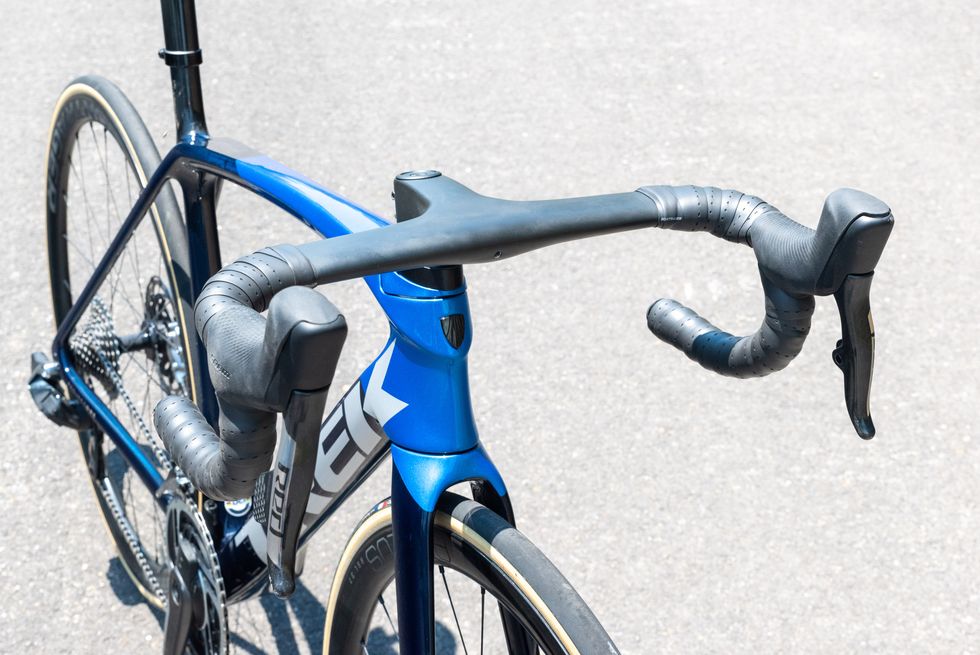
The integrated Aeolus is made of carbon-fiber composite, of course, with a claimed weight of 297 grams (42x120). It’s offered in 14 length and width combinations, from 44x120 to 38x80. Hoses, housing, and wires run externally for easier service and repairs, but in a groove that keeps them out of the wind. A bolt-on plate keeps the control lines tucked and organized where they turn off the bar tops to run in line with the stem.
The Aeolus employs a mount that works with Bontrager’s line of Blendr accessories for mounting computers and lights.
Aeolus 37 Wheels
Another new Bontrager product rolling out with the Émonda is the Aeolus 37 wheelset. It comes in two models: the Aeolus RSL 37 (1,325 grams/pair, $2,400) and the Aeolus Pro 37 (1,505 grams/pair, $1,300).
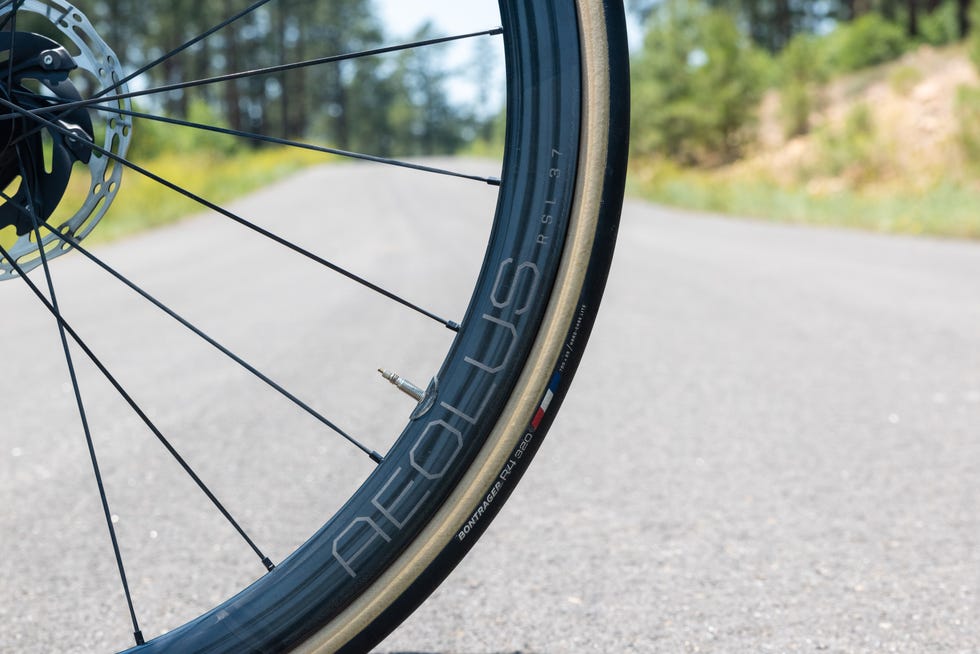
The RSL 37 is claimed to be lighter than Zipp’s 32mm-deep 202, yet more aerodynamic and more stable than Zipp’s 45mm-deep 303. Both wheels are disc brake only (only Center Lock interface), tubeless compatible, use DT-Swiss internals, have no rider weight limit, and come with a lifetime warranty.
Surprisingly Rider Friendly
Though the new Émonda is clean and integrated looking and uses high-performance standards, it is also remarkably rider-friendly. Cables, hoses, and housing run externally on the one-piece Aeolus bar/stem for easier repair and service (with one exception: wiring for a Shimano Di2 or Campagnolo EPS bar-end junction box runs partially inside the bar). If you prefer a more traditional cockpit, it can be run with a standard bar and stem with 1⅛-inch steerer clamp.
The bottom bracket uses the threaded T47 standard , which is compatible with almost all common crank-axle standards.
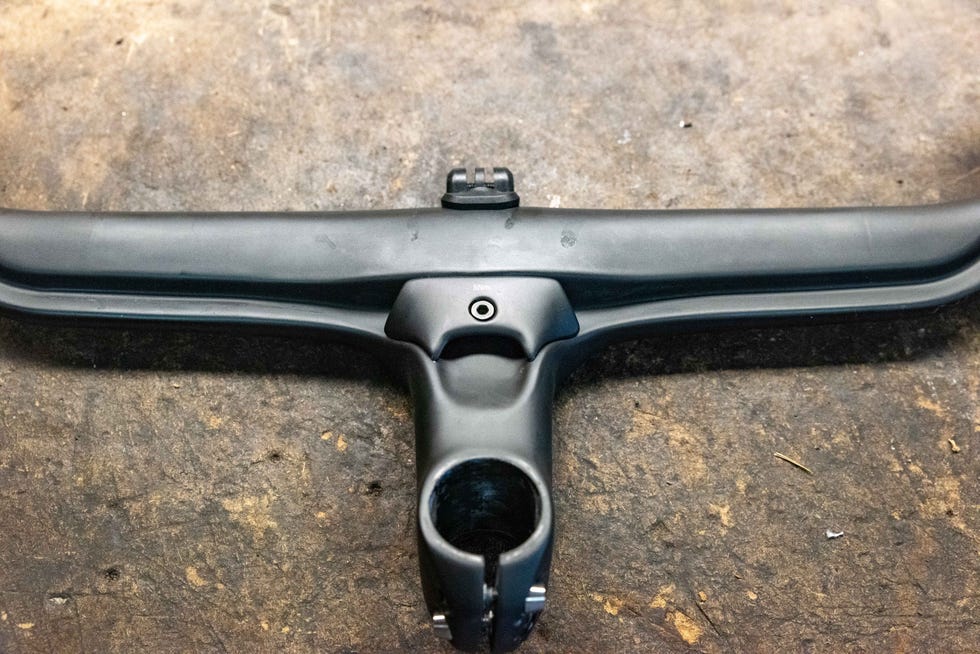
Front and rear thru-axles are standard 12x100 and 12x142mm, and the wheels employ a standard dish. The standard flat mounts for the brake calipers are compatible with 140, 160, or 180mm rotors.
Tire clearance is officially 28mm, but that’s with a ton of extra space. I fit 32mm tires in the Émonda with ease.
And though all models do use a seat mast, it’s a no-cut variety with lots of adjustment range.

H1.5 Geometry
Trek did offer its top-of-the-line race bikes in the aggressive H1 geometry for riders seeking an ultra-long and low geometry, or H2 which was an endurance fit. The new Émonda is offered only in H1.5, which splits the difference between H1 and H2. The result is pretty typical dimensions for a modern race bike—a 54cm Émonda H1’s geometry is remarkably similar to a 54cm Specialized Tarmac.
There are eight sizes starting at 47cm and topping out at 62cm.
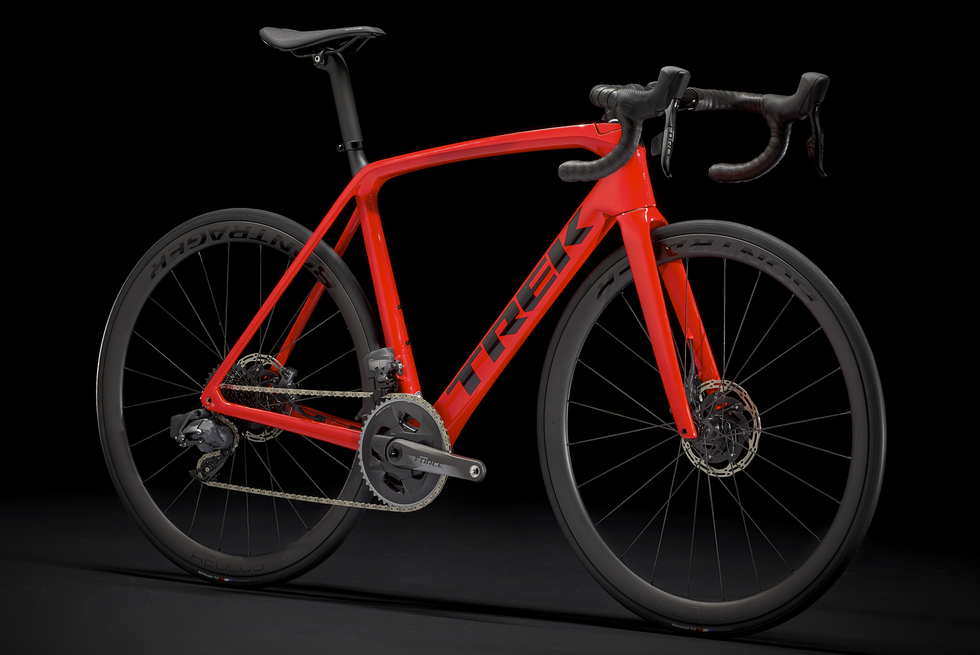
There are 10 models of the new Émonda. SL models start at $2,699 and are priced up to $5,999. SLR models start at $6,699 and go up to $11,999.
Only SLR models come with the Aeolus integrated bar/stem stock; and only the Émonda SL 7 ($5,499) and up come with the Aeolus 37 wheelset.
The new Émonda is a disc brake-only platform.
Project One
The new Émonda is in Trek’s Project One paint and parts personalization program. If that’s not luxe enough for you, Trek’s Project One Ultimate program allows you to work with a designer to come up with a one-of-a-kind finish, and Trek will source any parts you want for your new bike.

Trek Émonda SLR 9 eTap
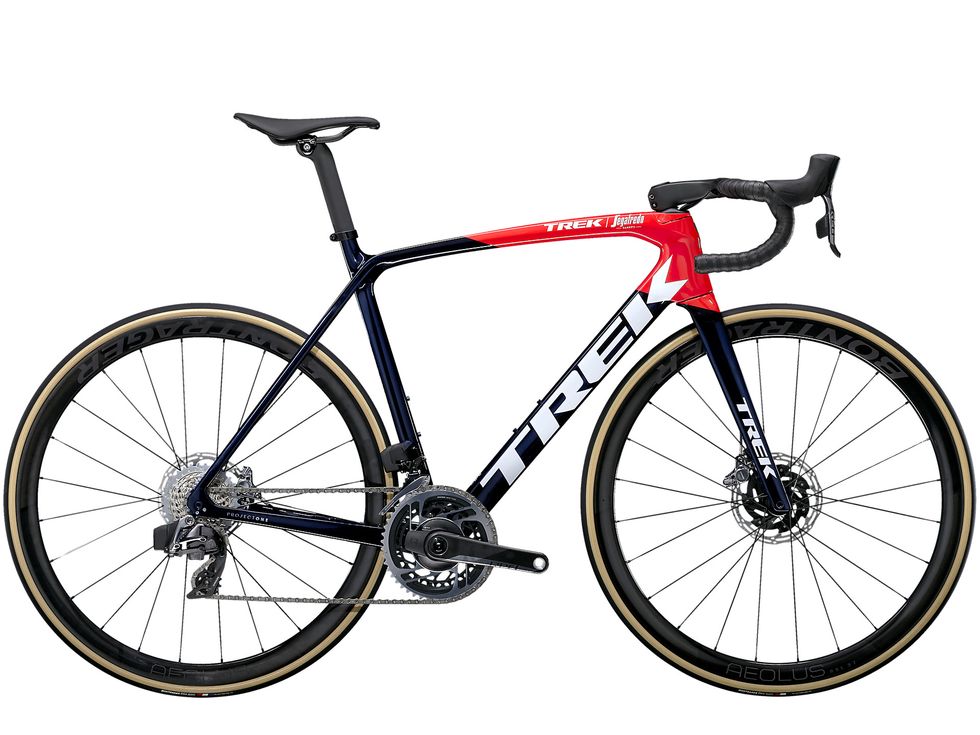
A gear editor for his entire career, Matt’s journey to becoming a leading cycling tech journalist started in 1995, and he’s been at it ever since; likely riding more cycling equipment than anyone on the planet along the way. Previous to his time with Bicycling , Matt worked in bike shops as a service manager, mechanic, and sales person. Based in Durango, Colorado, he enjoys riding and testing any and all kinds of bikes, so you’re just as likely to see him on a road bike dressed in Lycra at a Tuesday night worlds ride as you are to find him dressed in a full face helmet and pads riding a bike park on an enduro bike. He doesn’t race often, but he’s game for anything; having entered road races, criteriums, trials competitions, dual slalom, downhill races, enduros, stage races, short track, time trials, and gran fondos. Next up on his to-do list: a multi day bikepacking trip, and an e-bike race.
.css-7piy6r:before{width:1.75rem;height:1.75rem;margin:0 0.625rem -0.125rem 0;content:'';display:inline-block;-webkit-background-size:1.25rem;background-size:1.25rem;background-color:#F8D811;color:#000;background-repeat:no-repeat;-webkit-background-position:center;background-position:center;}.loaded .css-7piy6r:before{background-image:url(/_assets/design-tokens/latest/bicycling/static/images/chevron-design-element.c42d609.svg);} Bike Reviews

The 14 Best Electric Bikes, Tested by Our Editors

Trek Checkpoint & Checkmate Gravel Bikes Reviewed

This Bike Made Me Laugh, Cry, and Puke—Buy It!

The Specialized Crux DSW Is Simple and Brilliant

Best Hybrid Bikes You Can Buy Right Now

The 10 Best Mountain Bikes You Can Buy Right Now

Giant TCR Advanced Improves on Its Legacy

Speed, Balance, Refinement: Trek's Gen 4 Top Fuel

Tested: Trek’s Eighth-Generation Madone

Specialized’s Stumpjumper 15 Changes Trail Bikes
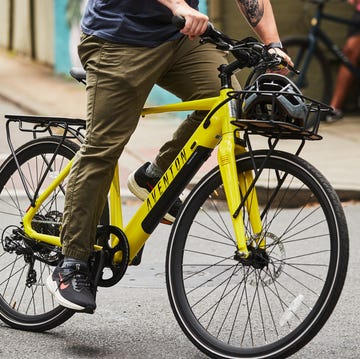
The 10 Best Cheap E-Bikes You Can Buy Right Now
- off.road.cc
- Dealclincher
- Fantasy Cycling
Support road.cc
Like this site? Help us to make it better.
- Sportive and endurance bikes
- Gravel and adventure bikes
- Urban and hybrid bikes
- Touring bikes
- Cyclocross bikes
- Electric bikes
- Folding bikes
- Fixed & singlespeed bikes
- Children's bikes
- Time trial bikes
- Accessories - misc
- Computer mounts
- Bike bags & cases
- Bottle cages
- Child seats
- Lights - front
- Lights - rear
- Lights - sets
- Pumps & CO2 inflators
- Puncture kits
- Reflectives
- Smart watches
- Stands and racks
- Arm & leg warmers
- Base layers
- Gloves - full finger
- Gloves - mitts
- Jerseys - casual
- Jerseys - long sleeve
- Jerseys - short sleeve
- Shorts & 3/4s
- Tights & longs
- Bar tape & grips
- Bottom brackets
- Brake & gear cables
- Brake & STI levers
- Brake pads & spares
- Cassettes & freewheels
- Chainsets & chainrings
- Derailleurs - front
- Derailleurs - rear
- Gear levers & shifters
- Handlebars & extensions
- Inner tubes
- Quick releases & skewers
- Energy & recovery bars
- Energy & recovery drinks
- Energy & recovery gels
- Heart rate monitors
- Hydration products
- Hydration systems
- Indoor trainers
- Power measurement
- Skincare & embrocation
- Training - misc
- Cleaning products
- Lubrication
- Tools - multitools
- Tools - Portable
- Tools - workshop
- Books, Maps & DVDs
- Camping and outdoor equipment
- Gifts & misc
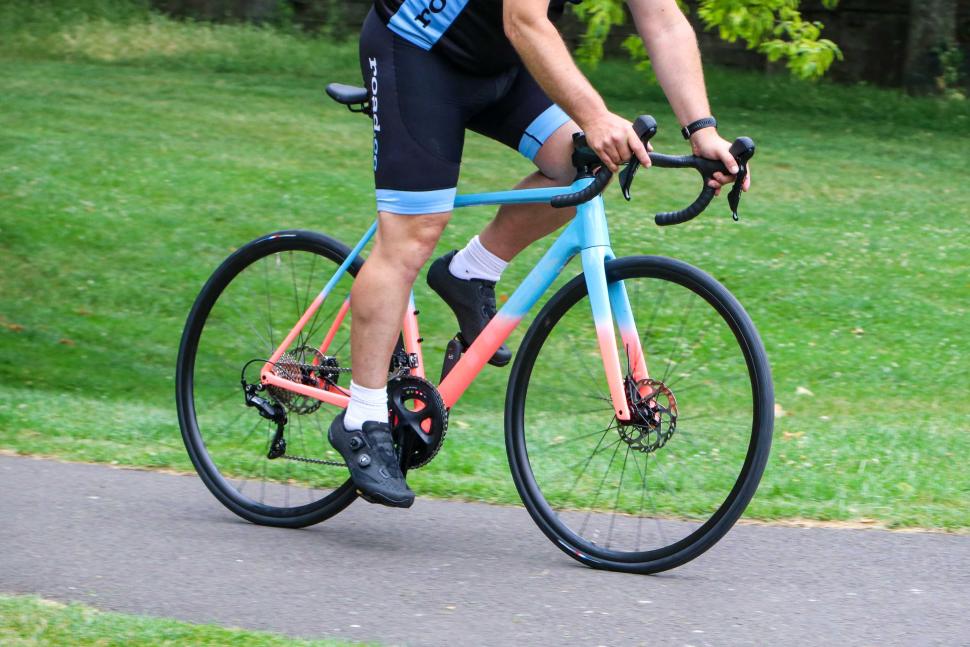
Trek Émonda ALR 5 2023
At road.cc every product is thoroughly tested for as long as it takes to get a proper insight into how well it works. Our reviewers are experienced cyclists that we trust to be objective. While we strive to ensure that opinions expressed are backed up by facts, reviews are by their nature an informed opinion, not a definitive verdict. We don't intentionally try to break anything (except locks) but we do try to look for weak points in any design. The overall score is not just an average of the other scores: it reflects both a product's function and value – with value determined by how a product compares with items of similar spec, quality, and price.
Good scores are more common than bad, because fortunately good products are more common than bad.
- Exceptional
- Not so good
The Trek Emonda ALR 5 uses the latest aluminium alloy Emonda frameset, with aero tweaks and a geometry that matches other high-end performance bikes in Trek’s line-up. It showcases the fact that this material still has a place on the racing scene, offering up the sort of stiffness and ride comfort found with carbon, although this build is far from light.
> Buy now: Trek Emonda ALR 5 for £1,999.99 from Triton Cycles
For more options and for different budgets, check out our guide to the best road bikes , from £300 to over £13,000…
I'm a big fan of aluminium frames. When done well, using the right tubing and wall thicknesses, and with well-thought-out geometry, it can result in a bike with excellent ride feel and great levels of feedback – everything a fast rider or racer wants. Trek has done an excellent job with this new Emonda ALR, which ticks all those boxes.
Even with the 25mm tyres pumped up firm, the aluminum tubing shows no signs of harshness, with an almost steel-like ride feel to it; there is a certain smoothness to it.
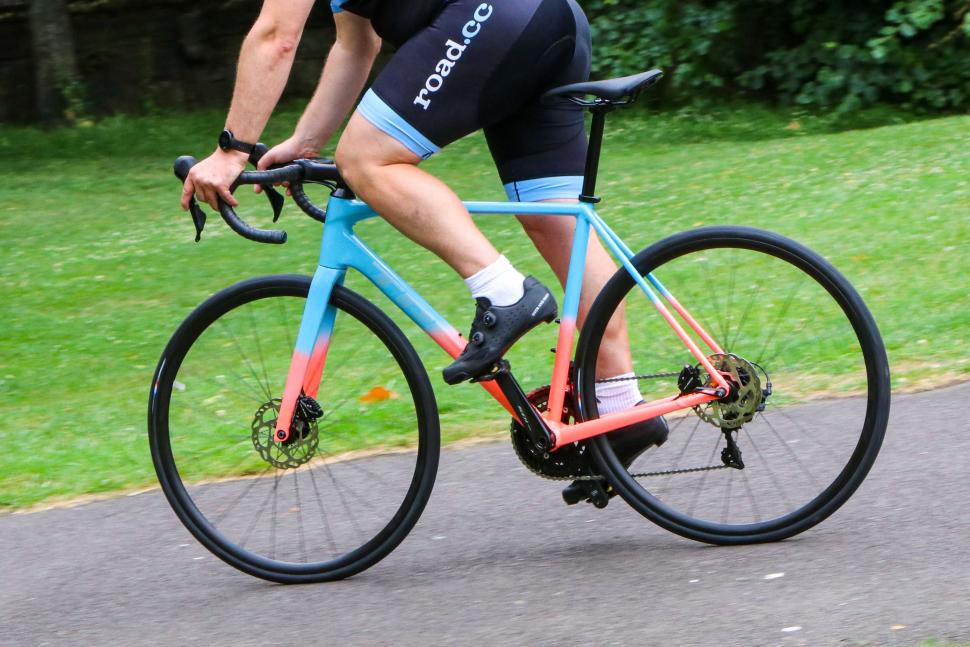
The frame is still incredibly stiff. Hard efforts out of the saddle don't show any signs of flex around the bottom bracket area, or anywhere else you might not want it. On the whole, it feels responsive and eager to get a shift on when you ask it to.
The only real fly in the ointment is the slightly lacklustre wheelset and the weighty tyres fitted as standard. Both take the overall shine off the performance, and contribute to the all-up bike weight of 9.1kg on our scales, so it's not exactly nippy off the line compared with bikes a kilo lighter.
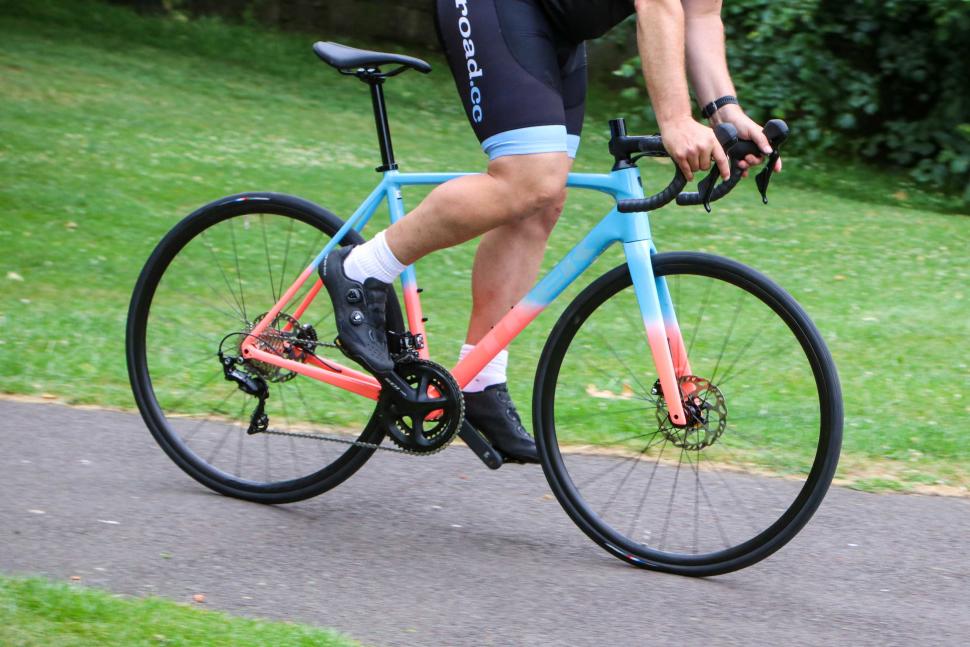
Swapping the Bontrager tyres out for some Goodyear Eagle F1 Supersport Rs that were in for review dropped 320g from the overall weight, and helped to show just what this bike is capable of. Not just in terms of weight, either, but also better rolling resistance and grip.
The better grip lets you get the best out of the geometry, which is designed to be on the racy side without being overly aggressive. It's a nice balance.
On fast descents you can fling it into the corners and it'll hold its line without feeling twitchy or nervous. In fact, it feels pretty planted, but not at the cost of responsiveness or nimbleness thanks to the sub-metre wheelbase.
It's a confidence-boosting bike, easy to ride even if you aren't giving things your full attention. You don't have to be 'on it' the whole time to ride the Emonda quickly; it'll just as easily let you cover big miles without issue.

Though the ALR has kammtail tube sections, and Trek makes some aero claims, I wouldn't say it feels exceptionally quick in a straight line; it doesn't have the sort of wind-cheating properties of properly aero carbon bikes.
That said, thanks to the riding position that's achievable given the reasonably low stack height, you can certainly get a shift on if you are trying to get out of the wind. It's certainly a bike you can race on, or just ride quickly without any competition involved.
Frame and fork
Trek uses its own range of aluminium grade tubing, which in the ALR 5's case is "ultralight 300 Series Alpha". And thanks to the hydroformed shapes, and what Trek calls invisible weld technology, it looks very much as smooth and shapely as many carbon frames on the market, especially around the head tube area.
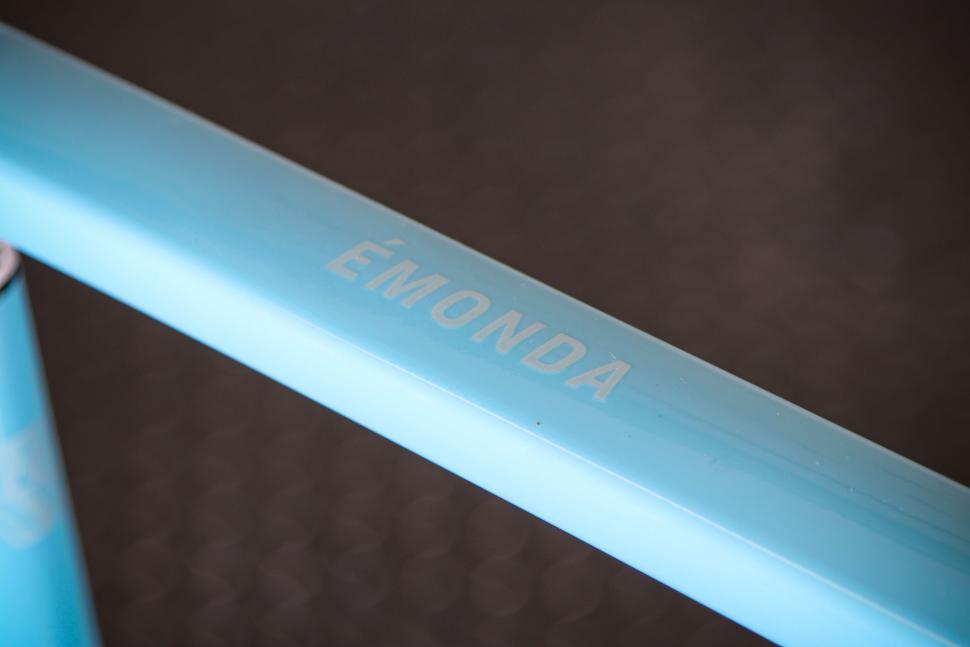
That smoothness is enhanced by the integrated cable routing, directed in through the head tube and headset before passing into the frame and exiting just below the bottom bracket.
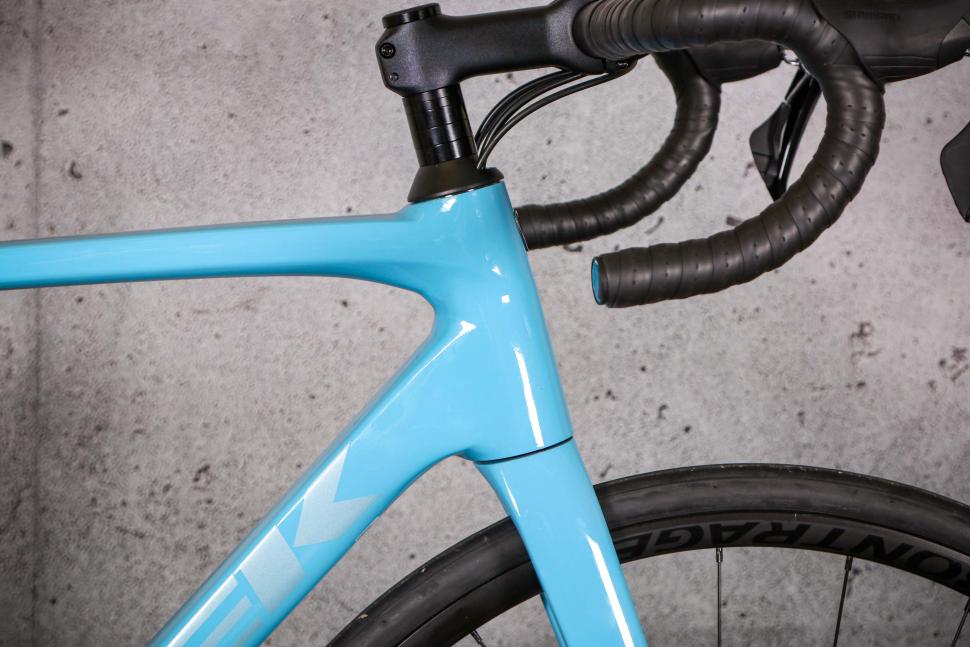
The welding only has a smooth appearance around the front area and the top of the seat tube, though; move further down where there are bigger loads being applied, such as at the bottom bracket, and the welds are much more pronounced.

The rear of the frame actually has quite a traditional look about it, with mainly round tubes and seatstays that aren't overly narrow or heavily profiled, like you might find manufactured from carbon.
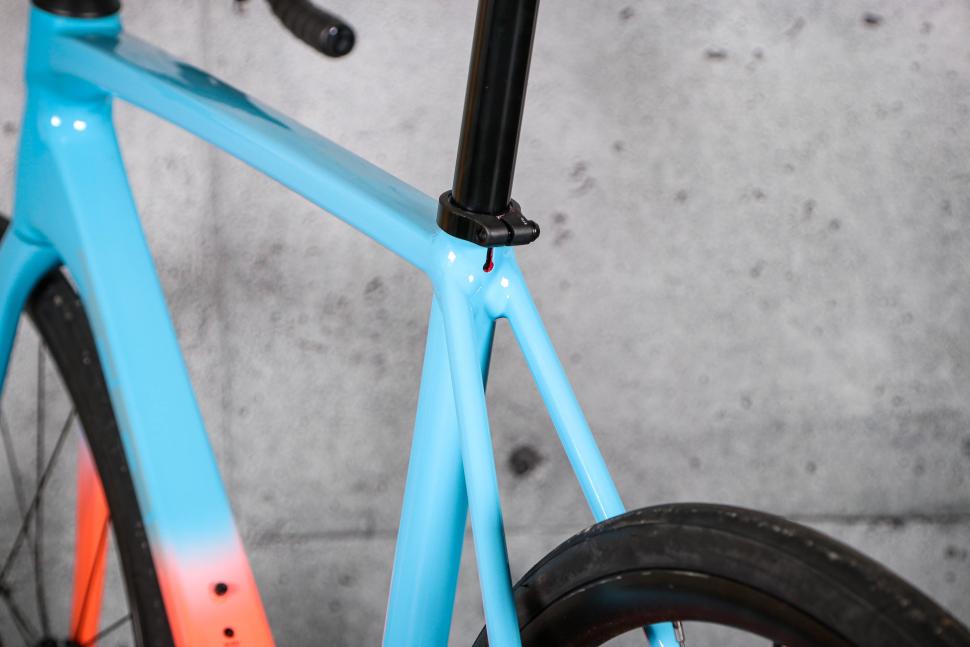
You won't find any integrated seatclamps either, with the Emonda getting a round post and a clamp that sits externally.

As for finishing touches, it's just bolts for two bottle cage mounts and nothing else. This is a performance race bike after all.

Tyre clearance is quite limited for a modern road bike at just 28mm. That's not a huge problem for me – 28mm is the maximum I use for this kind of bike – but with many of the opposition being able to take 30mm or even 32mm now, it's a little bit on the back foot.
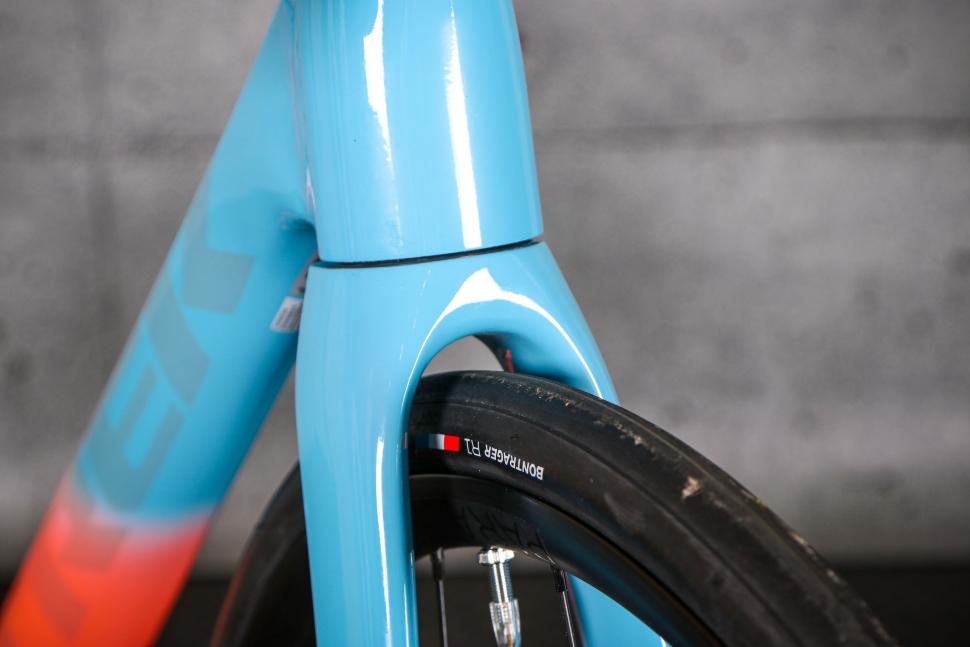
The carbon fork, an Emonda SL, blends smoothly into the frame and provides all the stiffness required for hard cornering without suffering from any kind of understeer at all.
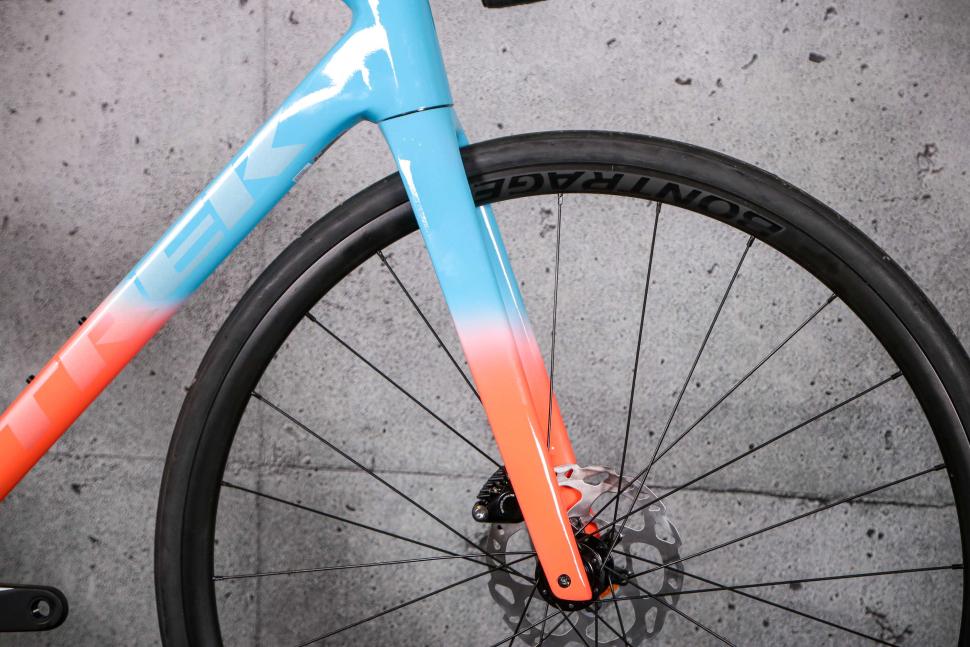
For the bottom bracket Trek has specced a T47, a switch it made a little while back. In a nutshell, it uses the larger dimensions of a press-fit system, but the bearings are threaded into the frame rather than being pressed. This provides the stiffness and performance benefits of a press-fit system without the creaking issues that can result if dirt gets in between the cups and frame due to poor manufacturing tolerances.
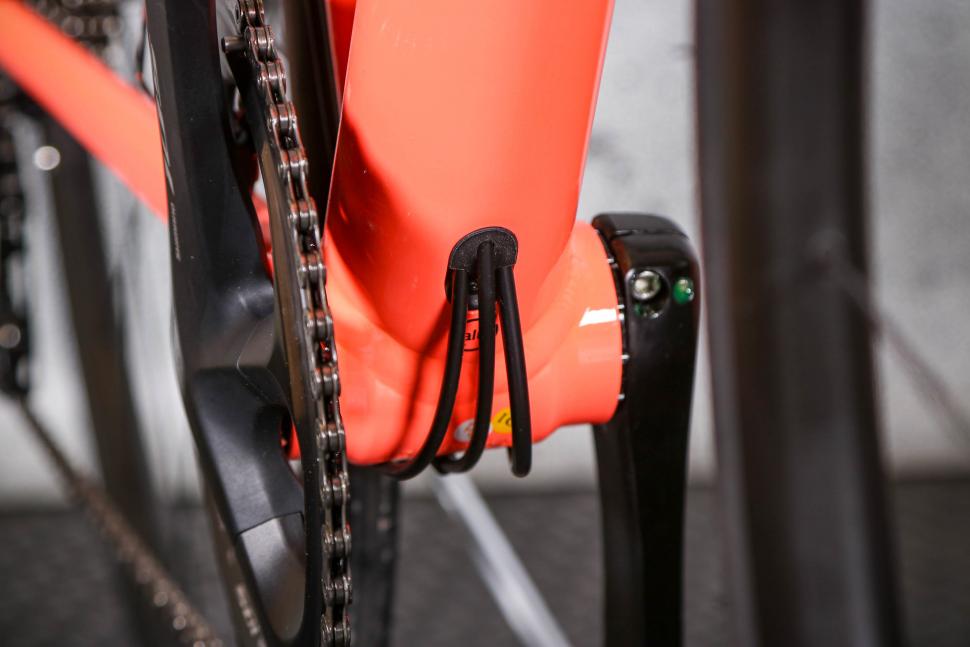
Geometry-wise, the Emonda ALR 5 uses Trek's H1.5 Race measurements, a balance of angles and dimensions that give the bike a performance edge without going too far into the twitchy, hard-to-handle realm of race bikes. It's the same as used on the higher-end carbon Emonda models.

Even though Shimano is 'charging' ahead with its electronic groupsets, and we've seen 105 Di2 become 12-speed, there is still a lot of life left in this mechanical setup. The shifting is great, with crisp and clean gear changes, and the shape of the levers lets your hands sit naturally and comfortably.

In terms of ratios, the ALR 5 comes with a 50/34-tooth compact chainset mated to an 11-30 cassette. That's a good spread of gears for all kinds of performance riding, with a 50x11 giving more top end than most people need, along with plenty of climbing gears at the lower end, providing you are reasonably strong and fit.
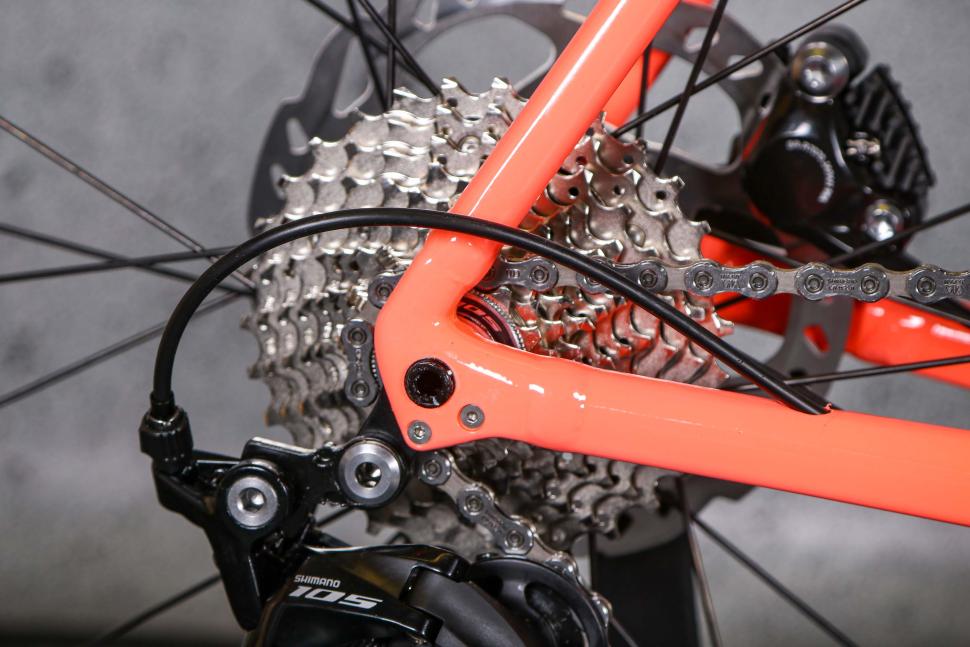
The hydraulic braking performance is top notch too. With 160mm rotors front and rear, you can get it to pull up from high speed to zero with just two fingers whenever you want.
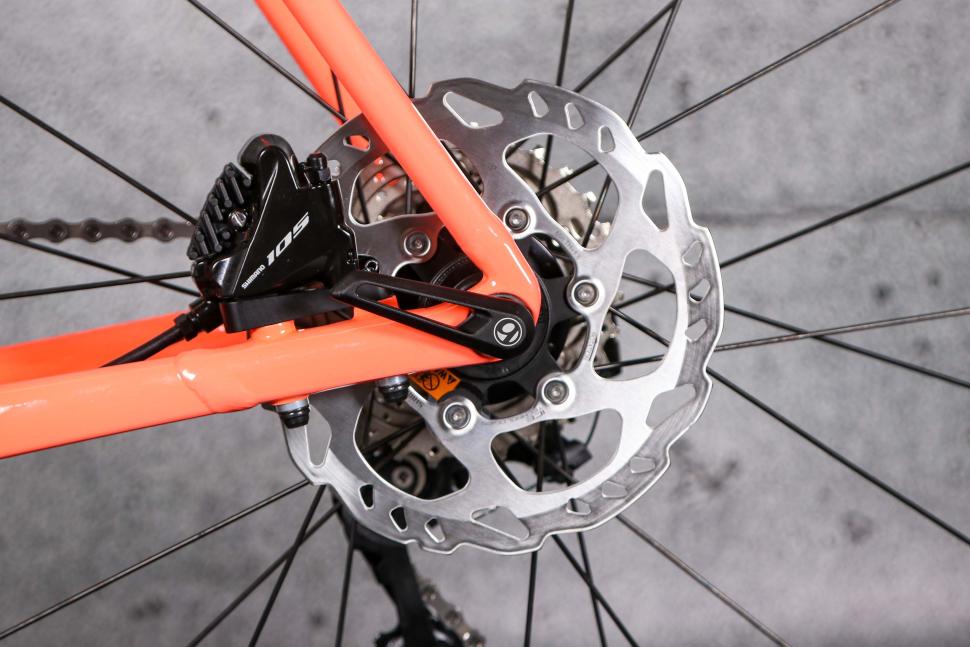
Finishing kit
Trek's in-house component and accessories brand, Bontrager, supplies all of the finishing kit found on the ALR.

The handlebar and stem are both standard alloy components with nothing flash when it comes to their design, but they do the job just fine.
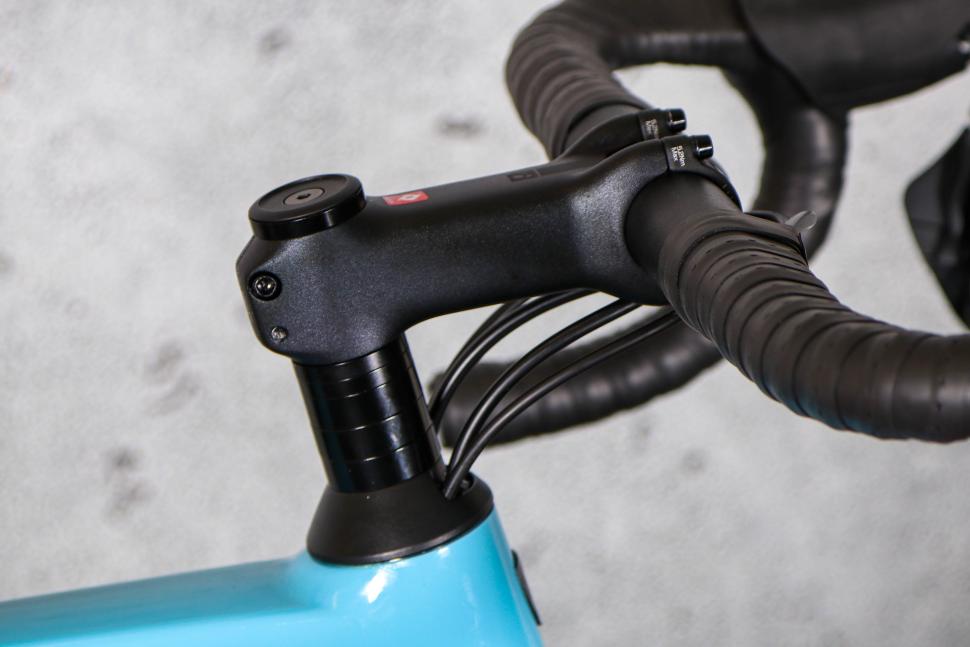
The Comp VR-C bar has a 124mm drop, which is shallow enough that it can be used without the bend in your back needing to be too extreme. The overall width is matched to the frame size.
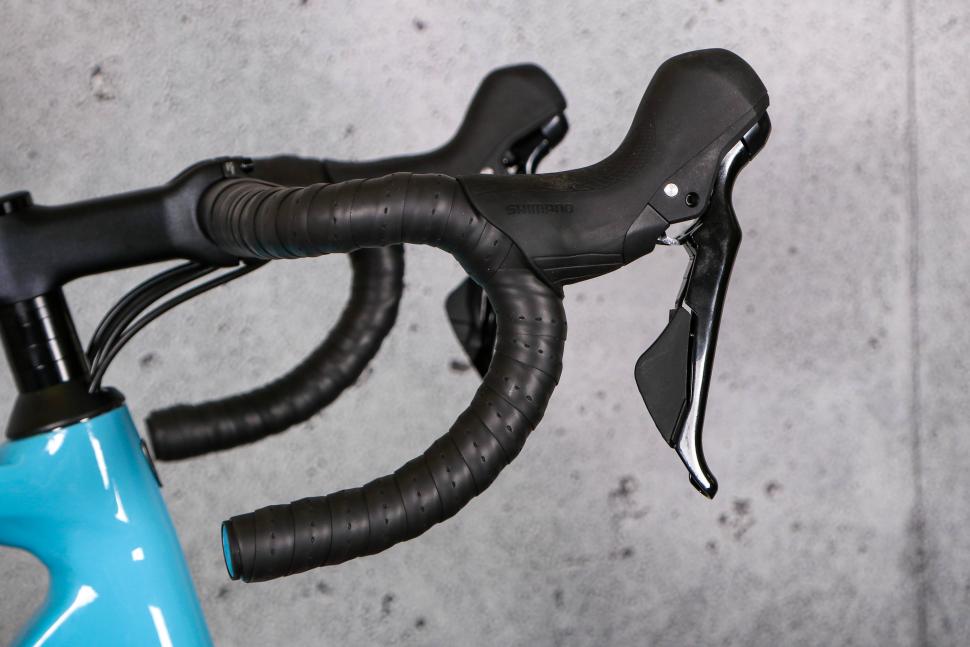
The seatpost is alloy too, 6061 grade, and is 27.2mm in diameter. It comes with 8mm of offset and on this size bike it is 330mm in length.

The Verse Comp saddle is a little too plush for my liking; I prefer something with less padding for fast riding, but saddles are very much a personal choice. You might get on with it just fine.
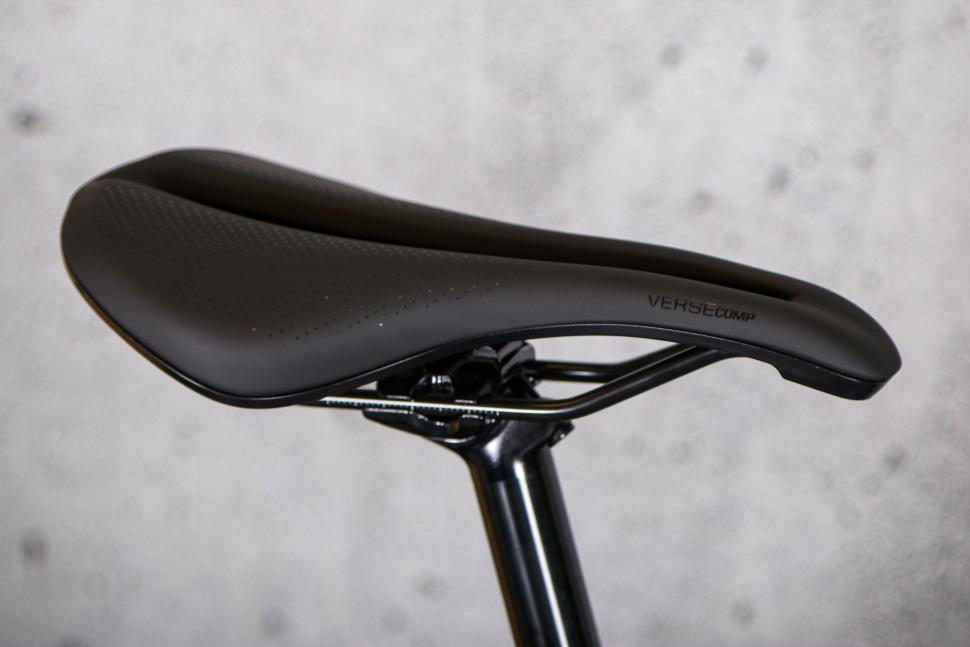
Wheels & tyres
As for the wheels, the Paradigm SLs are tubeless ready, and for a wheelset on a bike at this price point they aren't too bad in terms of weight at a claimed 1,800g.
Their shallow rim depth doesn't bring a huge amount of speed to the party, but they are stiff enough for spirited riding, and durability doesn't look to be an issue.

As I've already mentioned, the tyres fitted aren't the best from a performance point of view. They are heavy at over 800g a pair, and with a limited thread count they have quite a 'dead' feeling to them.
Durability and reliability aren't an issue, so they are good training tyres, but they just hamper performance. An upgrade here will bring dividends to overall speed, with better rolling resistance and grip.
The ALR 5 is priced at £2,350, which is similar to Cannondale's highly regarded CAAD 13 : an aluminium road bike with a lot of pedigree. (Mat tested the CAAD13 Disc 105 in 2020.)
The latest model is similarly specced with a 105 groupset and alloy mid-depth rims, so it's no surprise to see a price virtually the same either: £2,300.
Specialized's alloy superbike, the Allez Sprint Comp , takes many cues from the carbon fibre Tarmac SL7 . Liam was impressed with it overall when he tested it last year , and Jamie has bought a frameset, which you can see in our YouTube video comparing it against the ALR 5 . It's much higher priced than the Trek, though, at £2,900, with a 105 groupset and DT Swiss wheels.
Merida has a range of aluminium Sculturas, with the 400 being the most expensive. It too comes with a 105 mechanical groupset and an alloy wheelset, but costs much less at £1,775.
The ride quality and geometry of the ALR 5 makes it a bike I'd highly recommend if you want to race but don't have a massive budget, or you just want a bike you can ride fast without getting beaten up, even on long rides. It's priced in line with key competition like the CAAD13 and is cheaper than the Allez Sprint Comp by quite a long way. Some might baulk at that price for an alloy bike, but there is no denying it has the characteristics to back it up.
The tyres hold it back a bit, but underneath is a comfortable alloy road bike with a great performance
road.cc test report
Make and model: Trek Émonda ALR 5
Size tested: 56cm
About the bike
List the components used to build up the bike.
Hub front Bontrager alloy, sealed bearing, CenterLock disc, 100x12 mm thru axle
Skewer front Bontrager Switch thru-axle, removable lever
Hub rear Bontrager alloy, sealed bearing, CenterLock disc, Shimano 11-speed freehub, 142x12 mm thru axle
Skewer rear Bontrager Switch thru-axle, removable lever
Rim Bontrager Paradigm SL, Tubeless Ready, 24-hole, 21 mm width, Presta valve
Tyre Bontrager R1 Hard-Case Lite, wire bead, 60 tpi, 700x 25 c
Max tyre size 28c
Drivetrain -
Shifter Shimano 105 R7020, 11-speed
Front derailleur Shimano 105 R7000, braze-on
Rear derailleur Shimano 105 R7000, short cage, 30T max cog
*Crank Size: 47
Shimano 105 R7000, 50/34 (compact), 165 mm length
Size: 50, 52
Shimano 105 R7000, 50/34 (compact), 170 mm length
Size: 54, 56, 58
Shimano 105 R7000, 50/34 (compact), 172.5 mm length
Size: 60, 62
Shimano 105 R7000, 50/34 (compact), 175 mm length
Bottom bracket Praxis, T47 threaded, internal bearing
Cassette Shimano 105 R7000, 11-30, 11 speed
Chain Shimano 105 HG601, 11-speed
Max. chainring size 1x: 48T, 2x: 53/39 (Shimano), 48/35 (SRAM)
*Saddle Size: 47, 50, 52
Bontrager Verse Comp, steel rails, 155 mm width
Size: 54, 56, 58, 60, 62
Bontrager Verse Comp, steel rails, 145 mm width
*Seatpost Size: 47
Bontrager Comp, 6061 alloy, 27.2 mm, 8 mm offset, 250 mm length
Size: 50, 52, 54, 56, 58, 60, 62
Bontrager Comp, 6061 alloy, 27.2 mm, 8 mm offset, 330 mm length
*Handlebar Size: 47, 50
Bontrager Comp VR-C, alloy, 31.8 mm, 100 mm reach, 124 mm drop, 38 cm width
Bontrager Comp VR-C, alloy, 31.8 mm, 100 mm reach, 124 mm drop, 40 cm width
Bontrager Comp VR-C, alloy, 31.8 mm, 100 mm reach, 124 mm drop, 42 cm width
Bontrager Comp VR-C, alloy, 31.8 mm, 100 mm reach, 124 mm drop, 44 cm width
Handlebar tape Bontrager Supertack Perf tape
*Stem Size: 47
Bontrager Elite, 31.8 mm, Blendr-compatible, 7-degree, 70 mm length
Bontrager Elite, 31.8 mm, Blendr-compatible, 7-degree, 80 mm length
Size: 52, 54
Bontrager Elite, 31.8 mm, Blendr-compatible, 7-degree, 90 mm length
Size: 56, 58
Bontrager Elite, 31.8 mm, Blendr-compatible, 7-degree, 100 mm length
Bontrager Elite, 31.8 mm, Blendr-compatible, 7-degree, 110 mm length
Brake Shimano 105 hydraulic disc
Brake rotor Shimano RT70, CentreLock, 160 mm
Rotor size Max brake rotor sizes: 160mm front & rear
Tell us what the bike is for and who it's aimed at. What do the manufacturers say about it? How does that compare to your own feelings about the bike?
Trek says, "The Émonda ALR 5 gives you the sleek looks of carbon without the sticker shock. Its advanced alloy frame is built to perform, and pairs with disc brakes and a reliable Shimano 105 drivetrain to give it the race-ready edge."
It's a smooth looking bike with an excellent ride quality, and plenty of stiffness.
Where does this model sit in the range? Tell us briefly about the cheaper options and the more expensive options
The range is topped with the ALR 6 at £3,150 and starts with the ALR 4 at £1,750. A frameset is available too, from £1,150.
Tell us about the build quality and finish of the frame and fork?
It's a high-quality aluminium frame that looks smooth, just like a carbon fibre offering, and the fork is stiff enough for hard riding.
Tell us about the materials used in the frame and fork?
The frame is made from Trek's 300 Series Alpha aluminium while the fork is full carbon fibre.
Tell us about the geometry of the frame and fork?
The geometry is on the racy side, but just backed off enough to not create a twitchy speed machine.
How was the bike in terms of height and reach? How did it compare to other bikes of the same stated size?
The height and reach figures are fairly typical for a race bike of this size.
Riding the bike
Was the bike comfortable to ride? Tell us how you felt about the ride quality.
Yes, the alloy frame has a great ride quality.
Did the bike feel stiff in the right places? Did any part of the bike feel too stiff or too flexible?
With the oversized bottom bracket shell, and stiff tubing where it needs to be, all is fine in this respect.
How did the bike transfer power? Did it feel efficient?
Power transfer is good throughout the frame and fork.
Was there any toe-clip overlap with the front wheel? If so was it a problem?
How would you describe the steering? Was it lively neutral or unresponsive? On the quick side.
Tell us some more about the handling. How did the bike feel overall? Did it do particular things well or badly?
It has fast handling, but not so much so that it becomes twitchy or difficult.
Which components had the most effect (good or bad) on the bike's comfort? would you recommend any changes?
I wasn't a huge fan of the amount of padding on the saddle, although it is a decent shape.
Which components had the most effect (good or bad) on the bike's stiffness? would you recommend any changes?
I found the wheels fine for out of the saddle efforts, and the same with the handlebar – I didn't detect any flex when really pulling on it.
Which components had the most effect (good or bad) on the bike's efficiency? would you recommend any changes?
A change of tyres would improve overall efficiency a lot, by dropping weight and improving grip.
The drivetrain
Tell us some more about the drivetrain. Anything you particularly did or didn't like? Any components which didn't work well together?
Mechanical Shimano 105 is still an excellent groupset, with awesome shifting performance and braking power.
Wheels and tyres
Tell us some more about the wheels.Did they work well in the conditions you encountered? Would you change the wheels? If so what for?
Decent enough wheels for the budget, and not too bad a weight overall.
Tell us some more about the tyres. Did they work well in the conditions you encountered? Would you change the tyres? If so what for?
Entry-level tyres from Bontrager; an upgrade would benefit the bike immensely.
Tell us some more about the controls. Any particularly good or bad components? How would the controls work for larger or smaller riders?
Personally, I'd change the saddle for something less padded, but on the whole, for the money it's a decent spec.
Your summary
Did you enjoy riding the bike? Yes
Would you consider buying the bike? Yes
Would you recommend the bike to a friend? Yes
How does the price compare to that of similar bikes in the market, including ones recently tested on road.cc?
The similarly specced Cannondale CAAD13 Disc comes in a few quid cheaper at £2,300, but Merida's aluminium Scultura range stops at £1,775 even though you get a 105 mechanical groupset and a spec similar to that of the Trek. Specialized's Allez Sprint is considerably more, though.
Use this box to explain your overall score
Thanks to the quality that can now be achieved by modern aluminium frames, this is a lovely bike to ride, with easily enough stiffness to match that of carbon machines in the real world. It is weighty, and it could do with a few component tweaks, but for the performance it delivers, for the money, it's very good.
Overall rating: 8 /10
About the tester
Age: 44 Height: 180cm Weight: 76kg
I usually ride: This month's test bike My best bike is: B'Twin Ultra CF draped in the latest bling test components
I've been riding for: Over 20 years I ride: Every day I would class myself as: Expert
I regularly do the following types of riding: time trialling, commuting, club rides, sportives, fixed/singlespeed,
Help us to fund our site
We’ve noticed you’re using an ad blocker. If you like road.cc, but you don’t like ads, please consider subscribing to the site to support us directly. As a subscriber you can read road.cc ad-free, from as little as £1.99.
If you don’t want to subscribe, please turn your ad blocker off. The revenue from adverts helps to fund our site.
Help us to bring you the best cycling content
If you’ve enjoyed this article, then please consider subscribing to road.cc from as little as £1.99. Our mission is to bring you all the news that’s relevant to you as a cyclist, independent reviews, impartial buying advice and more. Your subscription will help us to do more.
As part of the tech team here at F-At Digital, senior product reviewer Stu spends the majority of his time writing in-depth reviews for road.cc, off-road.cc and ebiketips using the knowledge gained from testing over 1,500 pieces of kit (plus 100's of bikes) since starting out as a freelancer back in 2009. After first throwing his leg over a race bike back in 2000, Stu's ridden more than 170,000 miles on road, time-trial, track, and gravel bikes, and while he's put his racing days behind him, he still likes to smash the pedals rather than take things easy. With a background in design and engineering, he has an obsession with how things are developed and manufactured, has a borderline fetish for handbuilt metal frames and finds a rim braked road bike very aesthetically pleasing!
Add new comment

>£2k for an aluminium frame?! In the same price bracket, actually cheaper, you can get a carbon frame for that money. Trek seems to be poor vfm really....
- Log in or register to post comments
Or steel (if you want). Having become quite inured to these prices, I was slightly shocked recently to see you can get a well-regarded steel-framed 105-equipped ride for £1000 less than this Trek. Not exactly the same sort of bike but - hydraulic brakes apart - you have to wonder where the price difference comes from. www.cyclinguk.org/cycle-magazine/bike-test-cannondale-synapse-sora-and-s...
Coming back to cycling after a number of years off I was shocked at the cost of bikes and in the end plumped for a £500 Triban RC500 from Decathlon, which I'm sure a lot of folks will turn their noses up at, but it's a great bike and does everything I need. But now I'm looking at a better bike the vfm range is incredible. Have to say Ribbles range is looking very attractive.....
I tried one in Decathlon couple of weeks ago and thought it was a great bike especially for the price, now 600 quid I think.
Hornet99 wrote: which I'm sure a lot of folks will turn their noses up at
Anyone who does that is a fool. https://road.cc/content/review/decathlon-triban-rc-500-disc-road-bike-25...
Hornet99 wrote: >£2k for an aluminium frame?! In the same price bracket, actually cheaper, you can get a carbon frame for that money. Trek seems to be poor vfm really....
Your starting point is that aluminium is necessarily inferior to carbon. I'm not sure that's always true.
While this seems expensive for a 105 11-speed bike, it's a Trek and they don't sell bikes cheaply. The ALR 4 with Tiagra is currently £1,575 (reduced from £1,750). That's quite a difference for one extra cog on the cassette. The frameset is £1,150. A Specialized Allez Sprint frameset is £1,800.
These brands spend a lot on marketing, sponsorship and R&D and that money has to come from somewhere. I wonder how the Trek ALR compares to a Giant Contend SL, Cannondale Synapse or Ribble Endurance AL.
If you compare it with the £4,500 Cervelo Soloist reviewed last week which has a low-spec wheelset, so you're looking at £800 or more on top to get something it deserves (no-one buying a Soloist will want those stock wheels). I'd suggest that is a far bigger rip-off.
There is talk of an oversupply of some models so there may be discounts if you shop around.
No mention of that colour scheme!
Latest Comments
You're now doing 30 mile power walks aged 69 in addition to your previous claim of 45 km/h on the flat with no wind assistance whilst spinning out...
On the boundary of Edinburgh City, on the A92, is Cramond Brig, an ancient bridge (hence the name) over the River Almond. The bridge is closed to...
I actually just created a post in the forum before realising this had been posted. Absolutely disgusting waste of life and a terrible thing to...
chipping in as someone who uses this bike lane - It's pretty much as good as it gets in this country at the location in question, to be honest....
I went in the new Bristol branch at lunchtime. "Can I help you?", asks a staff member. "Yeah, I'm after a quick link for an eight speed chain",...
Just cycle through it anyway and if anyone try to stop you, just cycle away. It is not as if they can trace you.
The saying Empty vessels make the most noise seems to apply to this councillor.
I had him in and it was more for his price and the odd 10-20th place on GC days. A win was a big bonus.
Fairly uneventful ride today from Wadebridge to Chulmleigh. At around 1 PM I happened upon a very convenient pub, the Rising Sun Inn. The menu was...
Well - I hadn't watched that Dutch "bollards - and more" video for a long time - you can in fact see they have both "city centre retracting...
Related Reviews

Merida Scultura 4000 2024
Fun, fast and comfortable race bike at an affordable price
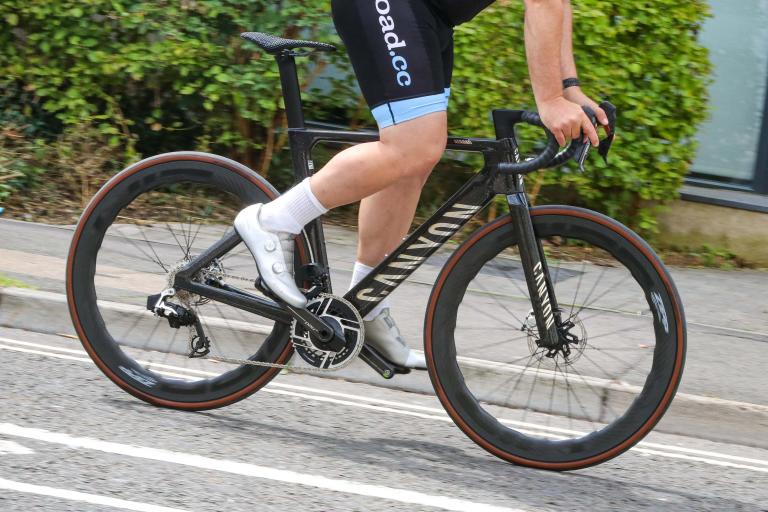
Canyon Aeroad CFR AXS 2024
Stunning performance right across the board from this versatile aero machine
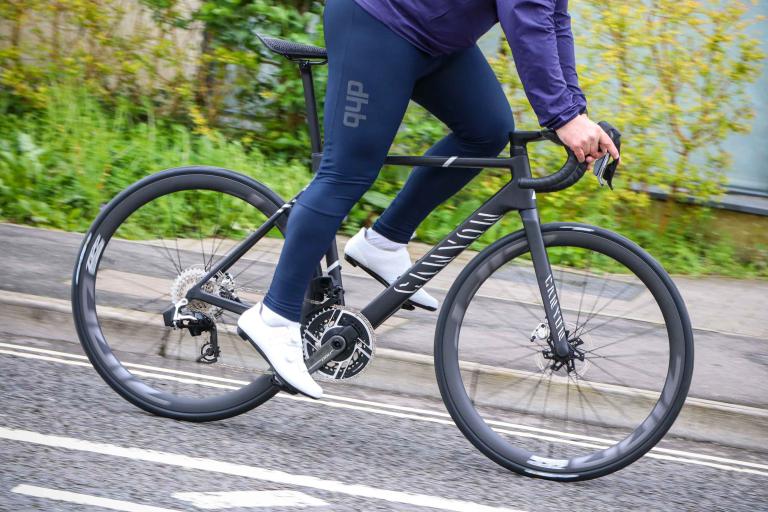
Canyon Ultimate CFR AXS 2024
Stunning performance thanks to excellent stiffness, a very low weight and a sublime ride quality

Enigma Eikon Frame 2024
Excellent in terms of the ride, and the handmade build quality is stunning

- Rider Notes
2018 Trek Émonda ALR 4

An aluminum frame race bike with mid-range components and rim brakes.
Manufacturer Price
For This Bike
View more similar bikes →
Based on frame geometry and build specs.
A bike with lower gearing will be easier to ride up steep hills, while a higher top end means it will pedal faster down hills.
Émonda ALR 4
Similar Bikes
(descending)
Add custom gearing

Dec 2018 · Philippe Tremblay
A stunning sparkling purple paint job on an alloy frame with s Shimano Ultegra disc brake build and Bontrager carbon hoops
Read Review

A smooth and stylee aluminum road bike that hauls ass at a great price

Aug 2018 · Benjamin Topf
The Trek Émonda ALR 6 is the highest-quality aluminium racer in Trek’s portfolio, but can the performance keep up with the superb looks?
May 2018 · Matt Wikstrom
Trek recently updated its lightweight racing chassis, the Émonda, with a variety of refinements for 2018, including the addition of a disc-brake version. We had a look at the Émonda SLR Disc when it was launched last year, so for this review, we follow that up with a closer look at the more affordable mid-range […]

Feb 2018 · Mat Brett
Quick and lively aluminium road bike with a good ride quality and excellent Shimano Ultegra components
Trek pares down its Émonda SLR race bike, resulting in a super-light frame that still handles wonderfully. Plus, it now is available with disc brakes.

May 2017 · Matthew Loveridge
The spec is average, but the Émonda’s frameset is an utter peach. Buy if you want the authentic Émonda experience at an everyman price
Outstanding ride, quality finish
No mudguard mounts

May 2017 · William Tracy
The aggressive and versatile Émonda SL 6 combines the stiffness you’d expect from a top-of-the-line race bike, with big tire clearance and moderate race

First added February 15
Last updated February 15
Not listed for 2,387 days

Please note that many of the links on our site are affiliate links. These are denoted with an *. By clicking on them, Femme Cyclist gets a small commission on any sale.
Trek Emonda ALR Review: A Fast Yet Affordable Road Bike
I don’t think there is anything in the cycling world better than “new bike day.” Or, well, so I’ve heard .
When I got my first road bike, I was honestly so overwhelmed with the idea of owning a nice bike that I am not sure I fully appreciated “new bike day!”

There were all of these thoughts, such as, “Will I ride it enough? Do I really need a bike? Gosh this is a huge investment!”
They almost overshadowed the fact that I was getting a new bike to begin with! Now, though, I know that I love to ride. I want ALL the bikes.
A cross bike, an e-bike, even a new road bike. You know, just because . I am quite sure there is no such thing as too many bikes, and I cannot wait to get my next one! I will be doing an extremely celebratory happy dance. A million photos will be taken. I will revel in its shiny newness.
Road bikes are obviously a huge investment, though. Therefore, it will hardly be a surprise that when I was offered the opportunity to try out a Trek Emonda ALR with Di2 I was an enthusiastic YES.
Interested in learning if the Trek Emonda ALR is right for you? Read on for our in-depth review of this amazing road bike!
Review in a Nutshell
- The Trek Emonda is FAST. This bike is built to race, and you can tell. I don’t race, but if I did I would definitely want an Emonda!
- Great on hills – I can climb hills faster on this bike than my carbon bike.
- It’s comfortable! For such a fast bike, I actually find it to be almost as comfortable as my Trek Domane (more of an endurance bike).
- It’s SOLID. The aluminum frame is SO sturdy.
- Even though it’s aluminum, it has a very light and responsive feel.
- The disc brakes are super responsive.
- The Shimano Di2 electronic shifting makes this bike so smooth and so easy to shift.
- The price! Likely the fact that it is aluminum keeps the price of this bike VERY economical for what you get.
- The Trek Emonda is built more for race than comfort, so if comfort is more important you might want an endurance road bike like a Trek Domane, or a hybrid bike.
- It is not carbon. For some people this is a deal breaker. I expected to be bothered by this and I wasn’t, and I kind of liked it, but this is still an important consideration if a carbon bike is important to you.
Price & Where to Buy:
- $2,299.99 List
- Buy at Trek Bikes.com*
The Trek Emonda ALR is a Fast Road Bike
If you are into road bikes, usually your brain tends to think “the faster the better” and this bike is fast . There are a lot of things that go into making a bike faster than another…weight, components, etc. The big thing that makes the Emonda ALR fast is that it’s “more aero.” The idea is that the whole entire bike is designed to be as aerodynamic as possible. It is lightweight (even though it’s aluminum) and it places your body in a less upright position so that you and the bike are creating less drag.

Trek also makes the Domane road bike, which is more of an endurance bike. This means that the bike is built for comfort, for long distances, and places you in a more upright position.
My current everyday road bike is a carbon Trek Domane, and I can absolutely say that the Emonda is a faster bike (even though it’s aluminum!). My times on similar rides/segments are faster with the Emonda. BUT it is definitely not as comfortable as the Trek Domane.
The Emonda is stiffer and when I go over bumps I feel it a lot more. If you are riding on rougher roads you will definitely prefer a carbon bike or a Domane to an Emonda!
I also find that for me the more aero position means that I have more pressure points between my soft tissue and my saddle.
This means that no matter how padded my bike shorts, or what saddle I use, I know that I am going to have at least a little more saddle/soft tissue pain with the Emonda.
For a shorter ride this really doesn’t bother me, but if I am doing a longer, endurance ride I would find myself reaching for the Domane.
A Lightweight, Aluminum Alternative to Carbon
I know, we kind of have it emblazoned into our heads that a carbon bike is always more lightweight and the better option, but it’s not quite that simple.

There are plenty of people who prefer the sturdier, stiffer feel of an aluminum bike, and aluminum bikes are not necessarily all that heavy!
Carbon is more expensive than aluminum, so if price is a concern, getting an aluminum road bike is a great option.
Trek has also done a lot of research into creating an aluminum bike that allows the stiffness and sturdiness of aluminum and the lightness of carbon. The fork in the Emonda ALR is actually carbon though, so this does lend to the bike being a bit lighter too!
According to Trek.com, an aluminum bike can provide enhanced stiffness and responsiveness, and their “Alpha Aluminum” technology means that their aluminum bike provides an experience “that rivals many of their carbon counterparts.”
The Emonda ALR is Stiffer and More Aero and You DO Feel It
That being said, the Emonda is stiffer and when I go over bumps I feel them a lot more.

This means that no matter how padded my bike shorts, or what saddle I use, I know that I am going to have at least a little more saddle/soft tissue pain with the Emonda.
This is not a problem for me on shorter club rides of 25 miles or so, but when I start pushing the 30/35 mile point on the Emonda I am feeling pretty ready to get off the bike.
You Can Climb Like a Beast With the Emonda ALR
This bike is a climbing machine. Some of this will definitely be personal preference, but there is just something about the stiffness of this bike that gives it an amazing, sturdy feeling when you climb.
When I am standing up on my bike I love to feel like I can really put some stress on it and have it hold up, and the Emonda ALR definitely gives me this!
I find that I can get up a hill a lot faster on the Emonda ALR than I can with my carbon Trek Domane. I think that part of this could be due to different gears/cassettes in the bikes too, so that is a consideration, but I just love how fast I can get up a hill with the Emonda in comparison. Hill climbing can be a very daunting part of cycling. There is nothing worse than feeling like you are slowing down to a crawl and barely moving. You start to question everything about your ability in those moments, and having a bike that makes you feel strong can really inspire confidence.
Components Matter
At the end of the day, whatever bike you choose, I would be remiss to not mention that the components can make a difference.
For example, the Trek Emonda ALR I am using has an Ultegra groupset which makes the bike a little bit lighter than the Shimano 105 that the ALR appears to come with standard. A groupset is the components that have to do with the braking mechanism/shifting of the bike, and the higher end the groupset, usually the lighter it is and potentially the better it performs. It also has Di2 electronic shifting which is, in a word, AMAZING. Electronic shifting is a little annoying because you have to charge the bike (we won’t talk about when I lost half my gears because I didn’t charge the darn thing). However, in terms of functionality it is so smooth and easy.

It also has Di2 electronic shifting which is, in a word, AMAZING. Electronic shifting is a little annoying because you have to charge the bike (we won’t talk about when I lost half my gears because I didn’t charge the darn thing). However, in terms of functionality it is so smooth and easy. If you get any hand/wrist pain electronic shifting is wonderful because your hands don’t have to work as hard to change gears.
Finally, the carbon wheels that were put on this Emonda ALR will also make it a little bit lighter than wheels that come stock on the bike.

If you can’t afford a carbon Emonda (they do run significantly more) you can consider upgrading the components on the Emonda ALR to get a faster ride. This is also a great option if you prefer the stiffness of an aluminum bike to begin with.
Trek is a Staple in the Cycling Industry
In 1976 Trek’s founders, Dick Burke and Bevil Hogg began producing Trek bikes in Southern Wisconsin. Today Trek is an internationally renowned cycling brand.

Trek sells bikes, bike accessories, and clothing. They have elite racing teams in pretty much every type of cycling event available. Trek even has STRAVA challenges annually where they give a little prize to everyone who rides at least 100 miles on STRAVA during this challenge. Whether you need a fast and fancy racing bike or your child’s first balance bike, it is likely that Trek makes a bike that will suit you. Trek is a top-tier cycling company with Trek retailers all over the US and all over the world.
From a bike owner’s perspective, the great thing about this is that you can likely find a retailer around you to purchase the bike, and maintain it for you too.
Bottom-Line Trek Emonda ALR Review
No single bike is going to work for everyone. A friend of mine had a beautiful carbon Emonda that she ended up selling because no matter what she tried, it just didn’t quite fit her right. My husband started on a Domane, switched to an Emonda, and much prefers the fit of the Emonda in terms of comfort.
Everyone has their own personal preference in terms of fit and speed. Some of us will be more willing to make the sacrifice of comfort for a little more speed. Others of us, not so much.
If you are looking for a racing bike, or just, like me, want to ride your road bike as fast as possible, the Trek Emonda ALR is a great, affordable option. Though it will be a bit heavier than its carbon Emonda counterpart, you can still go with a lighter groupset and upgrade the components to get a more economical, fast ride. To be very frank, I love this bike. It is a dream, and it is NOT going to be easy to give it back. My bike shop has given me an option to buy it though…one that I am seriously considering. If that’s not in the cards for me, though, maybe they will let me keep it for just a little bit longer!
Learn More About Choosing A Bike
- Ultimate Guide To Women’s Bike Sizes & Size Chart
- 19 Types of Bikes & How to Pick The Best For You!
About The Reviewer

Stacy Ann Smith is a New England-based cyclist who strives to stay upright on her bike. She is the founder of Sascy Cycling, and her mission is to encourage women to love their body and focus on what it can do, not what it looks like. When Stacy’s not cycling she is teaching high school history and eating pizza with her husband and son.
IG: @sascycycling
Leave a Comment Cancel reply
© Femme Cyclist 2024
Please note that many though not all, of the product links on our site are affiliate links. By clicking on them, Femme Cyclist gets a small commission on any sale. Read our full privacy policy for more information.
Trek Emonda SL6 Pro review
Trek's latest GC/climbing bike has undergone an aero transformation, but has it helped?
- Sign up to our newsletter Newsletter
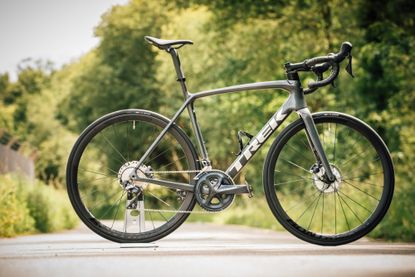
The radical changes brought about in this new Emonda frame are somewhat hampered within the SL range owing to the heavier nature of the frame and subsequent ride quality of the 500 Series OCLV carbon. It is a solid all-round performer and there's no getting away from the fact the ride quality provides a good balance of efficiency and ride comfort. It's just if you were looking for an improvement on the ride of the previous model you'll need to hold off and get one of the higher level SLR models to truly see improvements.
Efficient power transfer
Excellent handling prowess
Compliant ride
New SL frame has lost some of the excitement of the existing Émonda
Heavy for a 'climbing' bike
You can trust Cycling Weekly. Our team of experts put in hard miles testing cycling tech and will always share honest, unbiased advice to help you choose. Find out more about how we test.
Trek recently released a brand new re-imagining of the Emonda, the brand's lightweight climbing/GC model platform, featuring a drastically aero-ised chasis. The model family is split into a higher tier SLR and the lower SL range that this SL6 Pro sits in, the critical difference is in the carbon layup and the enhanced integration sported by the SLR range.
The frame on the Emonda SL6 Pro is constructed of Trek's own 500 Series OCLV carbon fibre. This carbon layup might be heavier than the newly showcased ultra light 800 Series OCLV of the top level SLR Émonda's but is considerably more economical to produce, helping keep the SL range prices in a much more affordable tier.
>>> The Trek Madone gets an update, but you won't spot it
The new Emonda features a completely new set of tube shapes, most of which have gone down the aero route. But Trek is at pains to keep the comparisons to the Madone aero race bike to a minimum; this isn’t simple a ‘Madone Lite’. Rather than being the same elongated shapes as found on a proper aero race bike, the aero shaping of the Emonda’s tubes is much more subtle and is based around the principle of unsteady aerodynamics.
>>> Best road bikes reviewed
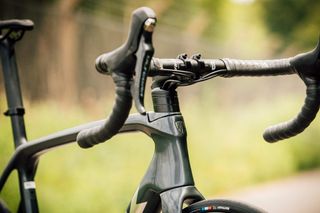
In this case it’s more about how drag is affected through wind gusts and other factors at slower speeds than the usual 45km/h, after all, not even pros climb at these speeds. There are still the characteristic truncated airfoil shapes that we associate with aero frames but the effect is far less dramatic and produces a frame that still has a traditional look.
Trek Madone SLR9 Disc review
Trek hasn’t jumped on the dropped seatstay bandwagon with the new frame either, preferring to stick to a set of widely spaced yet aero shaped, thin seat stays.
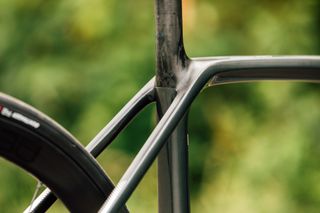
The new frame also enjoys a little more integration, bringing it more in-line with the Madone. All models now see the cable routing brought neatly into the frame at the front of the headtube keeping the front end profile as slippery as possible.
The other notable feature of the new frame is a wholesale move to the T47 bottom bracket standard . This style marries the reliability of a threaded shell with the capability of running larger diameter internal bearings and enables Trek to maintain its characteristic wide and efficient bottom bracket stance.
The new Emonda range has also been designed with Trek’s middle-ground H1.5 geometry ensuring a set of numbers that sits it half way between the ultra-aggressive pro H1 and its laid back and relaxed, endurance specific H2 geometry. A tall stack of split spacers under the stem provides plenty of height adjustment for a wide range of rider requirements.
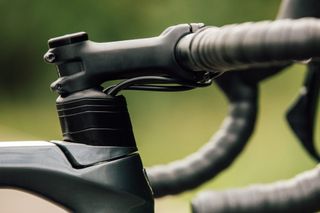
And finally, keeping the Emonda in a pretty rigid user set Trek has bucked another trend and limited tyre clearance to just 28c putting the focus of the bike purely on road going high performance.
The SL6 Pro sits near the top of the SL range and as such has a a pretty decent spec sheet. A mechanical Shimano Ultegra is the least we would expect at the +£3,000 price point and we don't need to point out how reliable and consistent it is in providing smooth shifting and braking.
As with the entire Emonda range the SL6 Pro runs on Bontrager wheels; Aeolus Elite 35 to be precise. These feature a carbon 35mm depth and complement the new 'aero' frame without compromising too much on weight and climbing ability. They feel stiff under power and spin up to speed relatively quickly. There are lighter and faster wheels that would suit the new frame but at this price point the Aeolus Elite is spot on. The tyres are Bontrager as well, in this instance 25mm R2 Hardcase Lite tyres. These are not Bontrager's fastest tyres, more classed as an everyday tyre with plenty of puncture protection.
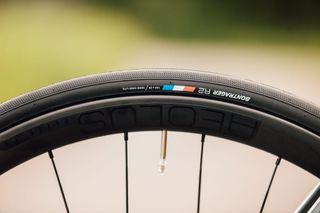
In a complete whitewash the entirety of the finishing kit is also provided by Bontrager. Unlike the integrated carbon bar/stem of the higher end SLR models, the SL6 Pro is fitted with a standard aluminium handlebar and separate stem, allowing for much simpler cockpit customisation. Despite the more ordinary setup the cable routing is still really neat underneath the stem without needing any additional housing.
The Émonda maintains the 'reversed' seat post, with a larger diameter seatpost mast fitted over the seat tube. This allows for plenty of adjustment plus further lengths are available if needed. The Bontrager Aeolus saddle also stands out for being incredibly comfortable even when sat right on the nose.

I was curious to see if the new Emonda was able to improve on the ride quality of the highly rated existing version and the short answer is yes, well kind of....
The first thing to note is that in this new guise, the lower SL version I have on test feels a little chunky at over 8 kilograms - not something you expect when the bike's raison d'etre is all about low weight and climbing. However a total mass doesn't always equate to an anchor of a ride experience and this is true of the Émonda.
Trek has managed to provide a level of stiffness around the bottom bracket that enables the Émonda to deliver in its promise of rewarding effort. Granted it takes less effort to maintain speeds on flat and rolling terrain, much like the Madone aero bike, and I'm certain it is a 'faster' bike than the last version. But I can't help but feel that this new design has stifled some of the existing model's lively and exciting ride nature - it feels like using adjectives such as solid and dependable is more appropriate, almost like the Domane endurance bike.

Trek's relaxing of the geometry on the Emonda has increased its ability to keep you comfortable and riding hard on a long ride and I had no issue taking on some challenging and long routes around Dorset and South Wales. The tall stack of shaped and split spacers sit the cockpit a little too high for my personal preference but luckily I was able to drop the stem height by using some standard spacers on top of the stem, without needing to cut the steerer. This put a little more weight on the front wheel which enabled me to descend the Émonda with aplomb and happily stuff it into downhill corners at high speed without any of the vague feeling that can come with a front end that is a touch too high.
Climbing is where the Emonda should thrive and it certainly is no slouch on your typical British climb, however it doesn't set the tarmac alight and the near eight kilo weight does neuter the Émonda's ability to counter attack when your riding mates try to accelerate away from you on a climb.
It feels like I'm being a little harsh and critical of the Emonda SL6 Pro, after all in most respects it is a solid all-rounder and I have enjoyed my time riding the bike over the last few months. It's a great looking bike and I expect most riders will be satisfied with the performance, it's just I feel it has a lost a little of the magic the old version had. If you are looking for the sort of engaging ride the Emonda is known for I suspect you would need to save your pennies and opt for one of the lighter SLR options and certainly if it was my money that would be what I would need to do.
Thank you for reading 20 articles this month* Join now for unlimited access
Enjoy your first month for just £1 / $1 / €1
*Read 5 free articles per month without a subscription
Join now for unlimited access
Try first month for just £1 / $1 / €1
Get The Leadout Newsletter
The latest race content, interviews, features, reviews and expert buying guides, direct to your inbox!
James Bracey's career has seen him move from geography teacher, to MBR writer, to Cycling Weekly's senior tech writer and video presenter. He possesses an in-depth knowledge of bicycle mechanics, as well as bike fit and coaching qualifications. Bracey enjoys all manner of cycling, from road to gravel and mountain biking.
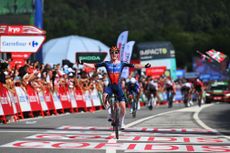
Huge break decides day in Galicia as race leader ships over 30 seconds to chasers
By Adam Becket Published 28 August 24
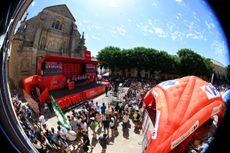
Isaac Del Toro will continue to ride while others fall by the wayside
By James Shrubsall Published 28 August 24
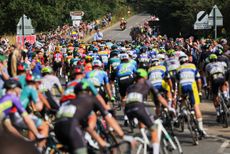
Your essential information to the UK's biggest men's stage race
By Tom Thewlis Published 28 August 24
Useful links
- Tour de France
- Giro d'Italia
- Vuelta a España
buyers-guides
- Best road bikes
- Best gravel bikes
- Best smart turbo trainers
- Best cycling computers
- Editor's Choice
- Bike Reviews
- Component Reviews
- Clothing Reviews
- Contact Future's experts
- Terms and conditions
- Privacy policy
- Cookies policy
- Advertise with us
Cycling Weekly is part of Future plc, an international media group and leading digital publisher. Visit our corporate site . © Future Publishing Limited Quay House, The Ambury, Bath BA1 1UA. All rights reserved. England and Wales company registration number 2008885.

COMMENTS
Explore the features and performance of the Trek Émonda ALR 4 road bike in this detailed review on BikeRadar.
Frame. Ultralight 300 Series Alpha Aluminum, Invisible Weld technology, tapered head tube, Control Freak internal routing, DuoTrap S compatible, flat mount disc, 142x12mm thru axle. BB Standard: BB86/BB92, 86.5mm, Press Fit. Fork. Emonda SL full carbon, tapered carbon steerer, internal brake routing, flat mount disc, 12x100mm thru axle.
Price: $960 (frameset), $1,890 (complete with 105 build) Weight: 16.4 lbs (as tested) Style: Road race. Drivetrain: Shimano Ultegra R8020 (as tested) Frame Material: Aluminum. Tire clearance: 28mm ...
The Emonda ALR by the numbers. On paper, it's hard to argue with Trek's new Emonda ALR. At least as far as the scale is concerned, the Emonda ALR is nearly on-par with the carbon fiber Emonda SL. Claimed frame weight for the disc-brake is 1,131g, and 1,112g for the rim-brake edition — just 40g heavier than its fancier (and more expensive ...
Trek Émonda ALR 5 review. May 2023 · Simon von Bromley. Trek's latest aluminium Émonda offers premium performance at a great price. Highs. Smooth ride quality. Confident handling. Easily customisable. Shimano 105 groupset continues to impress. Wide range of sizes.
The newest Trek Emonda SLR frame comes in at 650g, in a size 56cm, with the disc version tipping the scales at 665g. The slightly heavier SL versions are still hardly hefty, at 1091g and 1146g ...
The alloy Trek Émonda ALR disc review. Mar 2019 · Philippe Tremblay. Sleek looking and smart riding sparkling purple frame makes a strong case to build a dream machine with an aluminium frameset. Read Review. The Trek Émonda ALR Is a Sleek, Affordable Race Rocket. Aug 2018.
The Emonda ALR is yet more proof, as if we need it, that there's room for materials other than carbon in the heart of a serious roadie.
Trek Émonda ALR 5. $2,300 at Trek Bikes. Credit: Trek. Pros. A great riding aluminum frame with dialed fit and geometry. Mostly easy to service, adjust, and upgrade. Cons. Official max tire ...
Émonda ALR 4 Disc is a lightweight aluminum road bike with powerful hydraulic disc brakes, a quality drivetrain, and a frame that looks and handles like a far more expensive carbon bike. It's perfect for new riders, racers, and anyone who values the better braking performance and tire clearance provided by disc brakes. Compare.
How does the Trek Émonda ALR 5 perform on the road? Read our review to find out the pros and cons of this lightweight aluminum bike.
The Emonda ALR 4 is just 40g heavier than its fancier and costlier cousin, the SL, made from carbonfibre. Trek also say that the Emonda ALR 4 chassis is almost as stiff as the SL's. This is thanks to the 300-series Alpha Aluminium hydroformed tubes that use nearly the same shapes as the high-end Emondas. The frame features an internal cable ...
For the 99 percenters, there's the Émonda SL (models start at $2,699). The SL uses OCLV 500 composite, and the frame is quite a bit heavier than the SLR's. The SL's frame comes in at 1,142 ...
Bike Reviews; Road bike reviews; Trek Emonda ALR Disc 5 review. Trek has launched an updated aluminium bike in 2018. The new Trek Emonda ALR is a super lightweight machine that rides really well ...
Integrated, cartridge bearing, sealed, 1-1/8˝ top, 1.5˝ bottom. Brakeset. Shimano Tiagra. Weight. Weight. 56 cm - 8.89 kg / 19.60 lbs. Weight limit. This bike has a maximum total weight limit (combined weight of bicycle, rider, and cargo) of 275 pounds (125 kg).
Émonda ALR 4 is a lightweight aluminum road bike at an incredible value. But don't mistake it for the kind of ride you'll get from corner-cutting competitors at this price. Shaped tubes, Invisible Weld Technology, quality parts, and a lightweight frame make Émonda ALR a great road bike that will grow with you as your speed and skills advance.
The Trek Emonda ALR 5 uses the latest aluminium alloy Emonda frameset, with aero tweaks and a geometry that matches other high-end performance bikes in Trek's line-up. ... senior product reviewer Stu spends the majority of his time writing in-depth reviews for road.cc, off-road.cc and ebiketips using the knowledge gained from testing over ...
Read Review. The Trek Émonda ALR Is a Sleek, Affordable Race Rocket. Aug 2018. A smooth and stylee aluminum road bike that hauls ass at a great price. Read Review. Trek Émonda ALR 6 2018 Review. Aug 2018 · Benjamin Topf. The Trek Émonda ALR 6 is the highest-quality aluminium racer in Trek's portfolio, but can the performance keep up with ...
Trek continues to work on developing the Émonda, dropping the weight of the top end Trek Émonda SLR to 640g in a size 56cm (665g with discs) and 1091g for the Trek Émonda SL (1149g with discs ...
The Trek Emonda ALR is a Fast Road Bike. If you are into road bikes, usually your brain tends to think "the faster the better" and this bike is fast . The big thing that makes the Emonda ALR fast is that it's "more aero.". The idea is that the whole entire bike is designed to be as aerodynamic as possible.
Émonda ALR is a strikingly light, fast, and fun aluminum road bike that sprints and climbs like a true race bike. This affordable alloy speed machine boasts a race-specific geometry, aerodynamic tube shaping, and budget-friendly price tag that leaves you with enough cash to spend on sweet new kits, race registrations, and post-ride beers ...
As with the entire Emonda range the SL6 Pro runs on Bontrager wheels; Aeolus Elite 35 to be precise. These feature a carbon 35mm depth and complement the new 'aero' frame without compromising too ...